December 24 fire at Clairton Coke Works endangers public health, highlights nonattainment problem for sulfur dioxide
JANUARY 18, 2019 | POSTED BY CAC USER
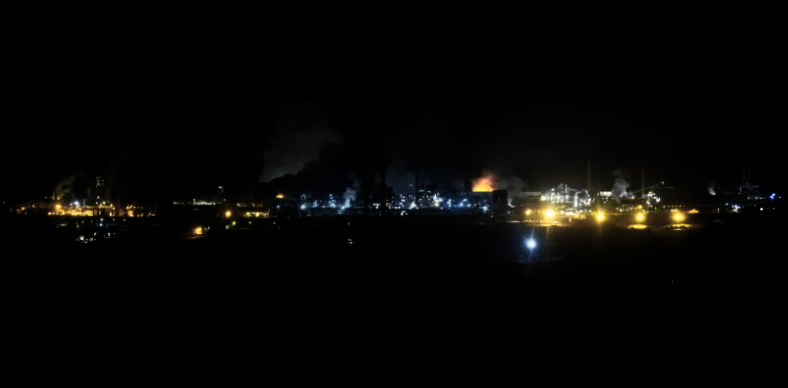
[Image Courtesy of the Breathe Project, December 24, 2018 at 04:26:25 (fire is the orange triangle to the right of center)]
[This webpage contains an inventory of resources regarding the Clairton fire and its aftermath, including press releases, company letters, public meetings, news reports, air monitoring data, air planning documents, and documents relating to the area's nonattainment with federal health standards for sulfur dioxide and fine particulates.
The information on this webpage was last updated as of Monday, January 27, 2019 to reflect updated air monitoring data near the end of this page]
Clairton, Pa. -- On December 24, 2018, a fire occurred at the No. 2 control room of the desulfurization unit of the Clairton Coke Works, which caused a failure of the system to channel coke oven gas to the two desulfurization units, controlled by No. 5 control room. This failure led to an ongoing release of air emissions from the burning of coke oven gas into the outside air, without sulfur controls. The primary air pollutant of concern is SO2 (sulfur dioxide), which can affect breathing and may aggravate existing respiratory and cardiovascular disease.
In addition, this could affect whether the county continues to fail to attain the national ambient air quality standard for sulfur dioxide (it has been in nonattainment status for 2013, 2014, 2015, 2016, 2017, and 2018: https://www3.epa.gov/airquality/greenbook/anayo_pa.html).
Finally, this has implications for the liability of U.S. Steel for noncompliance with its air permits.
The following are resources relevant to this incident. The icons below can be clicked to retrieve the underlying documents.
40. News Articles Regarding Fire and Aftermath
a. TribLive (Jamie Martines), Mon Valley residents at risk following fire at Clairton Coke Works (January 9, 2019), https://triblive.com/local/allegheny/14485570-74/mon-valley-residents-at-risk-following-fire-at-clairton-coke-works
SUMMARY: Report on statements regarding the incident by Jim Kelly, the Deputy Director for Environmental Health of the Department:
“Clairton Coke Works has exceeded federal standards for hourly sulfur dioxide emissions six times in the two and a half weeks since the fire, Kelly said Wednesday during a county Board of Health meeting. Kelly said coke oven gas is usually clean when it is released from the ovens, but the damage to the equipment following the fire has hindered the plant’s ability to remove sulfur from the gas.”
b. Environmental Health News (Kristina Marusic), Clairton Coke Works fire: What are the health effects of sulfur dioxide exposure? (January 14, 2019), https://www.ehn.org/clairton-coke-works-fire-what-are-the-health-effects-of-sulfur-dioxide-exposure
SUMMARY: Report on statements regarding the incident by Kevin Stewart, American Lung Association Director of Environmental Health, Advocacy and Public Policy:
"Stewart advised residents to follow health advisories that suggest limiting outdoor activity, keeping an eye on air quality data for the region as it becomes available, and being mindful of new symptoms.
Anyone with chronic lung or heart disease should have a plan in place with their physician(s), he said, in the event of an exacerbation or emergency caused by sulfur dioxide exposure."
c. Environmental Health News (Kristina Marusic), Kids in Clairton are experiencing decreased lung function following the Clairton Coke Works fire (January 15, 2019), https://www.ehn.org/pittsburgh-elementary-school-students-saw-increased-asthma-flare-ups-following-the-clairton-coke-works-fire-2626003196.html
SUMMARY: Report on observations by Dr. Deborah Gentile, who regularly monitors lung function and asthma control in a group of students at Clairton Elementary school as part of an innovative in-school asthma management clinic:
“When Gentile checked on Clairton students for a regularly-scheduled clinic on January 14, 2019, she reported that 36 percent of the students participating in the program had a significant decrease in lung function (14 of the 15 students participating in the program were in attendance).
….
In comparison, Dr. Gentile reported that there was no decrease in lung function among the nine enrolled in the same asthma program in Hazelwood, which is not one of the 22 neighborhoods included in the health advisory.
"These results show a temporal relationship between SO2 exceedances and deteriorating asthma control in children residing near the Clairton cokes facility," said Dr. Gentile in a press statement.”
d. Pittsburgh Post-Gazette (Don Hopey), Doctor: Coke oven problems may aggravate asthma in Clairton students (January 15, 2019), https://www.post-gazette.com/local/east/2019/01/15/Bad-air-may-trigger-Clairton-asthmas/stories/201901150167
SUMMARY: Report on observations by Dr. Deborah Gentile:
"Dr. Gentile said there appears to be a link between five students with aggravated asthma conditions and the six violations of federal sulfur dioxide standards by the coke works in the two weeks following the fire.
“Of course the sample size is small and we can’t 100 percent prove a link, but facts are facts and I do think there is a link,” said the doctor whose school-based clinic has been operating for five years."
e. StateImpact Pennsylvania and 90.5 WESA (Reid Frazier), Pittsburgh-Area Legislators Want Hearing On Clairton Coke Works (January 18, 2019), https://www.wesa.fm/post/pittsburgh-area-legislators-want-hearing-clairton-coke-works
SUMMARY: Report on the reactions of several local lawmakers to the aftermath of the Clairton fire:
"Now, several local lawmakers, like State Sen. Jay Costa, want the county to answer questions about its response.
....
Costa and State Sen. Jim Brewster and State Rep. Austin Davis sent out a press release Thursday calling for “immediate action” on the coke works, calling for more transparency from the county health department and US Steel, and a public hearing on the plant’s ongoing issues.
“The bigger question is how we deal with a violator — (a plant that) has been an ongoing violator of the air pollution standards,” Costa said."
f. Pittsburgh Post-Gazette (The Editorial Board), Achilles’ heel: Bad air quality requires more attention (January 22, 2019), https://www.post-gazette.com/opinion/editorials/2019/01/22/Achilles-heel-Bad-air-quality-requires-more-attention/stories/
SUMMARY: Editorial regarding the aftermath of the Clairton fire.
“There’s nothing like the sulfur dioxide emissions affecting 22 Mon Valley communities to show how poor air quality continues to undermine the region’s reputation, quality of life and prospects for advancement — and how zealous regulators must be about changing that.
….
On Jan. 9, the department awarded $300,000 in grants to community groups and municipalities with plans to plant trees, cut auto emissions and otherwise tackle air pollution. That’s great. But the focus has to be on keeping after the big, repeat polluters around the county. if the agency doesn’t do that, real progress on air quality will remain out of reach.”
g. Pittsburgh Post-Gazette (Don Hopey), 'We weren't told': Clairton residents demand action after Coke Works fire caused dangerous emissions (January 23, 2019), https://www.post-gazette.com/news/environment/2019/01/22/Clairton-residents-stay-hot-about-coke-plant-fire/stories/
SUMMARY: Report on public meeting at Clairton City Hall regarding aftermath of Clairton fire.
"At a meeting Tuesday that packed 120 people into Clairton City Hall, residents vented their frustration with the perpetually poor air quality of the Mon Valley town to representatives of the company, the Allegheny County Health Department and the city’s mayor and council."
“We weren’t told. That was the big problem for me and my constituents,” said Lee Lasich, a Clairton councilwoman. “Our people are concerned and it’s important for the city to get timely notification so we can give accurate information to our residents.”"
....
“Christopher Masciantonio, U.S. Steel’s director of public policy and government affairs, announced that the company will partner with Highmark on a new program to provide health screenings for Clairton residents experiencing new respiratory issues."
"Mike Rhoads, manager of the coke works, said the fire was caused by a “catastrophic mechanical failure in one of the compressors.” He said repair work is progressing and set a target date of May 15 to finish it."
....
"Matt Mehalik, executive director of the Breathe Project, a coalition of 24 environmental organizations that plans to hold a news conference Wednesday in Clairton, said the coke plant is continuing to operate in violation of its federal permit. He called on the steelmaker to idle the coke batteries until repairs to the gas system are finished.
“We’re not asking anyone to shut down the plant, just put it on hot idle,” Mr. Mehalik said as supporters in the audience waived “Hot Idle” and “Toxic neighbor” signs. “There’s 135,000 people living within five miles of the plant. What’s going to be done to protect the residents of the Mon Valley?”"
h. KDKA 2 CBS Pittsburgh (Kym Gable), Mon Valley residents Speaking Up About Air Quality (January 23, 2019), https://pittsburgh.cbslocal.com/video/4015293-mon-valley-residents-speaking-up-about-air-quality/ (video running time 2:34)
SUMMARY: Video report on the press conference of residents of Clairton and the Mon Valley.
i. 11 News WPXI, More air monitors being installed after dangerous gas release in Clairton (January 23, 2019), https://www.wpxi.com/news/top-stories/more-air-monitors-being-installed-after-dangerous-gas-release-in-clairton/908778141 (video running time 2:30)
SUMMARY: Video report on the press conference of residents of Clairton and the Mon Valley.
j. Pittsburgh Post-Gazette (Don Hopey), Passions still hot in aftermath of coke works fire that affected air quality (January 23, 2019), https://www.post-gazette.com/news/environment/2019/01/23/Passions-still-hot-in-aftermath-of-coke-works-fire/stories/201901230158
SUMMARY: Report on the press conference of residents of Clairton and the Mon Valley.
“Ms. [Colette] Williams was one of several dozen Mon Valley residents who joined environmental activists and several elected officials at a Wednesday afternoon news conference in Clairton to criticize the county’s and the company’s handling of the fire and its aftermath. They also called attention to what they say are systematic problems in how the plant’s pollution is policed and the health of Mon Valley residents is protected.”
“Matt Mehalik, executive director of the Breathe Project, a coalition of 24 environmental organizations, said the flaring of raw coke oven gas and the continuing operation of the coke production facility without use of the plant’s damaged pollution controls is illegal under terms of its federal permit.
He urged the health department to order the Pittsburgh-based steelmaker to put the plant on “hot idle,” which would keep the coke ovens heated and operational but suspend coke production until the pollution control equipment is operational. The company said the pollution controls could be fixed as early as May 15.”
….
“Meghan Cox, a U.S. Steel spokeswoman, issued a statement that said putting the coke works in hot idle is a lengthy process that would have taken company resources away from fixing the fire damage and created additional environmental and economic impacts.
She said the long-term impacts of a hot idle at Clairton “could mean the permanent closure of some of the impacted batteries, and other batteries would sustain damage that would impact the facility’s operation for several years.
“Such a hot idle action would likely have an adverse impact on the operating levels of all of our Mon Valley facilities and could result in workforce reductions,” she said.”
…
“The Allegheny County Health Department and U.S. Steel announced Tuesday that they will put additional sulfur dioxide monitors in the area.
One will be placed and activated near the coke works in Clairton later this week, and a second will be sited near U.S. Steel’s Irvin Works, where coke oven gas is being flared.
U.S. Steel is paying for the monitors and the data collected will be added to daily public reports available on the Health Department website and Facebook page.”
k. StateImpact Pennsylvania (Reid Frazier), Residents, environmental groups call for Clairton plant to go on ‘hot idle’ (January 23, 2019), https://stateimpact.npr.org/pennsylvania/2019/01/23/residents-environmental-groups-call-for-clairton-plant-to-go-on-hot-idle/
SUMMARY: Report on the press conference of residents of Clairton and the Mon Valley.
“Some Clairton residents and environmental activists are calling on the Allegheny County Health Department to force US Steel to put the Clairton Coke Works on hot idle while it repairs the plant’s pollution controls. They made their case at a news conference Wednesday arranged by local environmental groups.”
“Chelsa Wagner, Allegheny County controller, used her remarks to call out county executive Rich Fitzgerald for not publicly calling for greater scrutiny of the Clairton plant, the largest coke plant in North America. The facility is one of the biggest sources of air pollution in the region, and air quality nearby is some of the worst in the country.
….
In a statement, Amie Downs, county spokeswoman, said the county executive had “been talking about the need to hold Clairton and US Steel accountable for years” and praised Hacker’s work as the health department director.
The statement pointed to the department’s enforcement order issued in June, in which the county threatened US Steel with a partial idling of the plant if it didn’t clean up its emissions. US Steel is appealing that order.
“Dr. Hacker is the strongest advocate for air quality and health that this county has ever had,” the statement said. “She has invested in the department and ensured that they are pushing the envelope on enforcement and other actions related to air quality.”
l. TribLive (Jamie Martines), Mon Valley residents, advocacy groups call for more action on air quality (January 23, 2019), https://triblive.com/local/allegheny/14536473-74/mon-valley-residents-advocacy-groups-call-for-more-action-on-air-quality
SUMMARY: Report on the press conference of residents of Clairton and the Mon Valley.
““We don’t want to damage the plant, we want the damage to stop,” said Matthew Mehalik, executive director of the Breathe Project, said following a news conference at the Community Economic Development Corp. of Clairton on Wednesday.
A hot idle could allow the facility to keep its equipment running at the temperatures necessary to prevent it from breaking while cutting back on production — and, in turn, reducing the pollutants that could be released while the equipment that cleans coke oven gas is being fixed, he said.”
….
“The Allegheny County Health Department has considered a hot idle, said Dr. Karen Hacker, the department’s director, adding that the move is one of the penalties of an enforcement order issued by the Health Department against U.S. Steel in June.
But that order is not tied to the Dec. 24 fire. Rather, it is tied to the ongoing compliance issues, Hacker said.”
m. Environmental Health News (Kristina Marusic), Clairton residents plead with officials to protect them from pollution following US Steel fire (January 24, 2019), https://www.ehn.org/clairton-residents-plead-with-officials-to-protect-them-from-pollution-following-u-s-steel-fire-2626830057.html
SUMMARY: Report on the press conference of residents of Clairton and the Mon Valley.
“Residents from eight communities surrounding the Clairton Coke Works gathered alongside environmental advocates in Clairton on Wednesday to share their concerns about the health impacts of a recent influx in air pollution resulting from an accident at the plant nearly a month ago.”
….
“Mehalik pointed out that a coke battery in New York was recently shut down by state regulators because of repeated Clean Air Act violations, while Lee reiterated that they're not expecting similar action in Clairton.
"What we're asking for is not unreasonable," said State Rep. Summer Lee. "We're not asking them to shut it down. We're still making concessions even though we're dying."
n. PublicSource (Oliver Morrison), Residents, officials push for answers from U.S. Steel and Allegheny County about response to Clairton Coke Works fire (January 24, 2019), https://www.publicsource.org/residents-officials-push-for-answers-from-u-s-steel-and-allegheny-county-about-response-to-clairton-coke-works-fire/
SUMMARY: Report on the press conference of residents of Clairton and the Mon Valley.
“Melanie Mead, a longtime Clairton resident, questioned the way the county was using emergency room visits to track whether the air pollution was causing a problem. The health department reported that there had not been an increase in emergency room visits for asthma. But Mead said many people like her can’t afford to go to the emergency room, so the impact wouldn’t show up in emergency room visits."
o. TribLive (Jamie Martines), New air quality monitor added in Clairton (January 29, 2019), https://triblive.com/local/allegheny/14555580-74/new-air-quality-monitor-added-in-clairton
SUMMARY: Report on the Department's installation a new air monitor in Clairton:
“The first of two new air quality monitors in Clairton is operational this week.
Located at the Clairton Education Center, the new monitor will also measure sulfur dioxide, or SO2, emissions, according to an update provided by the Allegheny County Department of Health.
….
The Clairton Education Center was selected because of its location, health department spokesperson Ryan Scarpino said in an email Monday.
“It’s in a different wind direction from the Coke Works than our other monitors, and therefore offers additional information about potential air quality issues in Clairton,” he said.
The second monitor will be placed in a to-be-determined area near U.S. Steel’s Irvin Works, about five miles from the Clairton Coke Works in West Mifflin, Scarpino said.
Coke oven gas is flared at Irvin Works.”
p. Pittsburgh Post-Gazette (Daniel Moore), U.S. Steel reports repairs following Clairton plant fire will cost about $40 million (January 30, 2019), https://www.post-gazette.com/business/pittsburgh-company-news/2019/01/30/Clairton-plant-fire-cost-U-S-Steel-40-million-coke-health-pollution/stories/201901300152
SUMMARY: Report on the cost of repairs in the aftermath of the Clairton fire:
“U.S. Steel expects to pay at least $40 million to repair damage caused by a mechanical fire at its coke plant in Clairton that triggered an air quality alert from Allegheny County health officials, the Pittsburgh steelmaker has told investors.
….
.... About $15 million to $20 million will go to repair structures, while the other about $20 million will go to purchasing natural gas to temporarily replace the coke oven gas.
Executives said there will be additional costs related to Clairton repairs in the second quarter this year.
….
In a fourth quarter earnings report released after the markets closed Wednesday, the company reported a full-year 2018 profit of $1.1 billion, or $6.25 per share, compared with $387 million, or $2.19 per diluted share, in 2017.
Sales rose 16 percent to more than $14 billion in 2018 -- its highest revenue mark since 2014. The company has benefited from higher U.S. steel prices and higher demand for its products after tariffs on steel imports from some countries were imposed in March.”
q. TribLive (Jamie Martines), County officials meet with health department, discuss Clairton Coke Works fire (February 6, 2019), https://triblive.com/local/allegheny/14585594-74/health-department-officials-meet-with-allegheny-county-officials-to-discuss-clairton-coke
SUMMARY: news report discuses a meeting between members of the Allegheny County Council and the Health Department.
"Allegheny County Council members met with Health Department officials Wednesday to discuss the ongoing impact of a Dec. 24 fire at Clairton Coke Works that hindered the facility’s ability to clean coke oven gas and remove sulfur dioxide pollution."
r. KDKA-TV (Paul Martino), Mon Valley Air Quality Public Hearing Attracts Many People (February 7, 2019), https://pittsburgh.cbslocal.com/video/category/spoken-word-kdkatv/4024822-mon-valley-air-quality-public-hearing-attracts-many-people/
SUMMARY: report on the State Senate and House Democratic Policy Committee meeting on air quality in Clairton.
s. WTAE Pittsburgh's Action News 4 (Marcie Cipriani), Clairton residents, US Steel employees pack air quality hearings; Clairton Coke Works fire still under investigation (February 7, 2019), https://www.wtae.com/article/mon-valley-air-quality-concerns-continue-after-sub-zero-temperatures-clairton-coke-work-repairs-continue/
SUMMARY: report on the State Senate and House Democratic Policy Committee meeting on air quality in Clairton.
"Residents and employees of U.S. Steel filled council chambers in Clairton to listen as lawmakers, representatives from Clairton Coke Works and the Allegheny County Health Department discussed air quality concerns in the Mon Valley. Meanwhile, repairs continue at Clairton Coke Works after a fire in a control room inside the plant in December. Many of those who showed up to the hearing, could not fit inside the room and instead filled the hallway and the steps outside."
Transcript of Reporter (Marcie Cipriani): "While the opinions and the crowd was divided, most officials and lawmakers agree, the goal is not to shut down the steel industry, but to make it safer for everyone. Lawmakers say this is really a fact finding mission. They are trying to figure out whether air quality and the economy can work together. This is something we will continue to follow and whether any changes come out of this meeting we will let you know."
t. TribLive (Jamie Martines), State lawmakers meet to discuss air quality concerns following Clairton Coke Works fire (February 7, 2019), https://triblive.com/local/allegheny/14589438-74/residents-pack-meeting-with-lawmakers-about-clairton-coke-works-fire
SUMMARY: report on the State Senate and House Democratic Policy Committee meeting on air quality in Clairton.
u. WPXI-TV (Erin Clarke), Air quality concerns are focus on public hearing in Clairton, (February 7, 2019), https://www.wpxi.com/news/top-stories/air-quality-concerns-are-focus-on-public-hearing-in-clairton/916169093
SUMMARY: report on the State Senate and House Democratic Policy Committee meeting on air quality in Clairton.
v. WESA 90.5 FM, StateImpact, WITF (Amy Sisk), Clairton Coke Works hearing draws suggestions, criticism over fire response (February 8, 2019), http://www.witf.org/news/2019/02/lawmakers-clairton-coke-works-hearing-draws-suggestions-criticism-over-fire-response.php
SUMMARY: report on the State Senate and House Democratic Policy Committee meeting on air quality in Clairton.
39. Allegheny County Health Department’s Webpage for the Clairton Fire
This is the Department’s webpage regarding the Clairton fire and aftermath: https://alleghenycounty.us/Health-Department/Programs/Air-Quality/Mon-Valley-Air-Quality.aspx
The Department has also made information available on its Facebook page: https://www.facebook.com/AlleghenyCountyHealth/
The Department also maintains a webpage for hourly concentrations for multiple pollutants at all official monitoring stations throughout the county: https://www.alleghenycounty.us/Health-Department/Programs/Air-Quality/Monitored-Data.aspx (note that this webpage only provides data going back one week). The relevant sulfur dioxide monitors at the two monitors located at Liberty 1 and North Braddock.
38. Complaint in PennEnvironment, Inc. and Clean Air Council v. United States Steel Corporation (W.D. Pa. 2019) (Civil Action No.: 2:19-cv-00484-AJS) (Filed April 29, 2019)
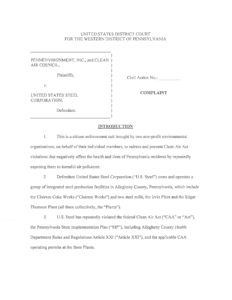
SUMMARY: On April 29, 2019, environmental organizations commenced a legal action against the company in the U.S. District Court for the Western District of Pennsylvania, for failing to operate its desulfurization plant and violating emissions limitations over the course of several months. The plaintiffs seek the following remedies:
a. a declaration that the company has violated its air permits and the Clean Air Act,
b. an order requiring the company to comply with its air permits and the law,
c. an order requiring the company to implement measures to remedy, mitigate, or offset the harm to public health and the environment,
d. an order requiring the company to develop and implement a contingency plan to prevent unauthorized combustion of coke oven gas as fuel or in flares when pollution controls are inoperable,
e. the assessment of an appropriate civil penalty of up to $97,229 per day for each violation,
f. an order that $100,000 of the civil penalty be used in beneficial mitigation projects that are consistent with the Clean Air Act and enhance the public health and the environment in the areas adversely affected, and
g. an award to plaintiffs of their costs of litigation (including reasonable attorney and expert witness fees).
37. Press Release, Health Department Revises Enforcement Order Issued Against Mon Valley Works (March 12, 2019)
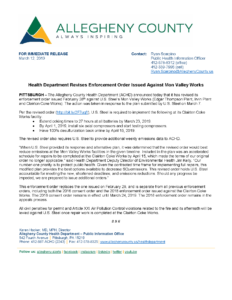
SUMMARY: Health Department announces the issuance of a revised Enforcement Order that supersedes the order on February 28, 2019:
"U.S. Steel is required to implement the following at its Clairton Coke Works facility:
• Extend coking times to 27 hours at all batteries by March 23, 2019.
• By April 1, 2019, install six axial compressors and start testing compressors.
• Have 100% desulfurization back online by April 15, 2019.
The revised order also requires U.S. Steel to provide additional weekly emissions data to ACHD."
36. Enforcement Order #190202A, Allegheny County Health Department (March 12, 2019)
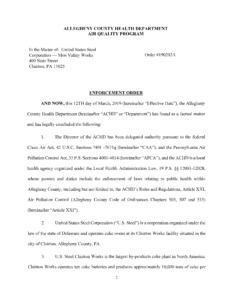
SUMMARY: The Department issues a revised Enforcement Order that supersedes the Enforcement Order issued on February 8, 2019. The Health Department accepts the company's updated mitigation plan (extending coke oven times to 27 hours, rather than the 30 hours sought by the Department), and removing the imposition of the 13,597.59 pounds per day cap on sulfur dioxide emissions from the three facilities. (pages 11-12). The Department requires a compliance date of March 23, 2019, five days sooner than the date proposed by the company.
35. Notice and Explanation of Impossibility and Conflict With Existing Legal Obligations, by U.S. Steel (March 7, 2019)
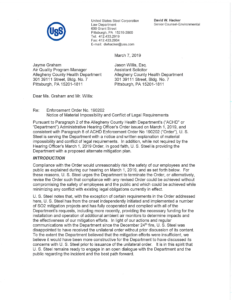
SUMMARY: U.S. Steel sets forth a number of reasons why it believes it cannot comply with the Allegheny County Health Department's Enforcement Order, including (1) extending coking times or reducing coal charges would affect stack opacity and fugitive emissions and would jeopardize the safety of employees (page 3, pages 9-12), (2) it is materially impossible to hot-idle batteries within 35 days (page 7), (3) compliance with the Enforcement Order would cause noncompliance with underfire stack opacity and soaking requirements in a 2016 Consent Judgment (page 8).
U.S. Steel sets forth its own proposed mitigation plan:
"Updated Mitigation Plan
• Further extended coking times and coke production from 11,000+ tons per day (pre-fire) to approximately 8,000 tons per day (by March 28th - see schedule for extended coking below) to reduce the coke oven gas generated.
• Continue to expedite the repairs so that the No. 2 and No. 5 Control Rooms could be restarted by April 15, 2018.
• At the reduced production, 100% of the coke oven gas will be able to be processed at the No. 2 and No. 5 Control Rooms.
• Adjust coking times thereafter, ensuring that 100% of the coke oven gas can be processed to accommodate any additional coke oven gas" (page 13).
34. Order Granting a Temporary Stay for U.S. Steel (March 1, 2019)
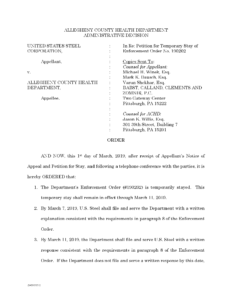
SUMMARY: The Administrative Hearing Officer grants a temporary stay to U.S. Steel, effective through Monday, March 11, 2019 (paragraph 1).
By Wednesday, March 7, the company must submit a written explanation why it believes there is a conflict between the Enforcement Order and other legal obligations. (paragraph 2).
By Monday, March 11, the Department must submit a written response, and if such a response is not submitted the temporary stay will continue until there is a decision on the petition. (paragraph 3).
A telephone status conference is scheduled for Monday, March 11 at 2 pm. (paragraph 4). The Administrative Hearing Officer will consider whether to extend the temporary stay if the parties have not resolved the matter. (paragraph 4).
The Administrative Hearing Officer will hold a hearing on the petition for stay on March 26, 2019 at 9:30 am.
33. Petition for Stay by U.S. Steel (March 1, 2019)
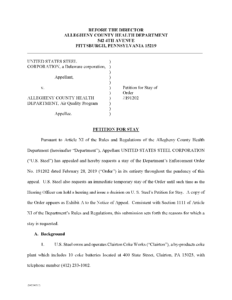
SUMMARY: U.S. Steel requests that the Administrative Hearing Officer issue a stay of the Enforcement Order, based on reasons similar to those set forth in the Notice of Appeal. The company asserts that "[a] stay is appropriate because U.S. Steel is likely to succeed on the merits in this action." (paragraph 17).
32. Notice of Appeal by U.S. Steel (March 1, 2019)
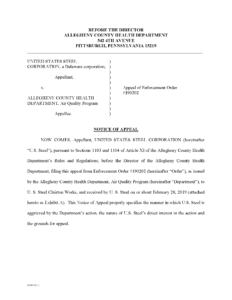
SUMMARY: U.S. Steel appeals the Enforcement Order to an Administrative Hearing Officer of the Department, asserting it is impossible to meet the requirements of the Enforcement Order within the specified timeframes in a legal and safe manner. (paragraph 7(a)). It also asserts that the Department did not determine that the air emissions are endangering public health. (paragraph 7(d)). It also asserts that there is a conflict between the Enforcement Order and other legal obligations. (paragraph 7(e)).
31. Press Statement, Breathe Project (February 28, 2019)
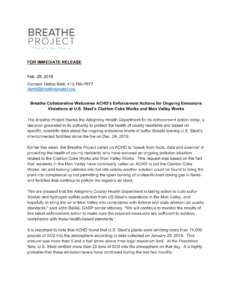
SUMMARY: Breathe Project responds to the Department's issuance of the Enforcement Order.
30. Press Statement, PennEnvironment and Clean Air Council (February 28, 2019)
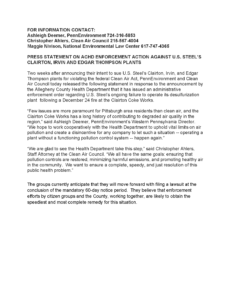
SUMMARY: PennEnvironment and Clean Air Council respond to the Department's issuance of the Enforcement Order.
29. Enforcement Order #190202, Allegheny County Health Department (February 28, 2019)
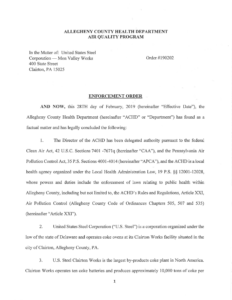
SUMMARY: Allegheny County Health Department issues Enforcement Order for violations of air permits at the Clairton facility, Edgar Thomson facility, and Irvin facility:
13. .... U.S. Steel's own emissions data revealed that just prior to and following the December 24 fire, its H2S grain loading across its Mon Valley facilities was as follows:

14. U.S. Steel's Clairton Installation Permit #0052-I011b (Condition IV.27), Edgar Thomson's Installation Permit #0051-I006 (Condition IV.27), and Irvin's Installation Permit #0050 I008 (Condition IV.25) impose a site wide limit for sulfur compound emissions to no more than 35 grains/100 dscf.
15. U.S. Steel's SO2 emissions skyrocketed after the fire as noted in the chart below:

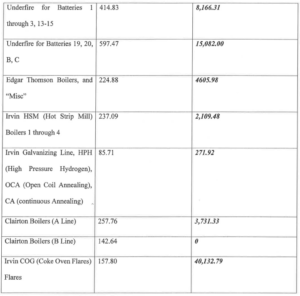
19. Based on the foregoing information provided by U.S. Steel concerning its SO2 emissions across all three of its Mon-Valley facilities, the Department concludes that the current pollution mitigation strategy is not working.
....
PENALTY ASSESSMENT
1. Starting March 1, 2019, U.S. Steel shall extend coking time across all batteries by no less than an additional fifteen minutes every day until such time it has reached the Minimum Required Coking Time as set forth below:
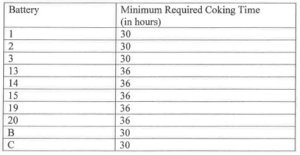
2. U.S. Steel shall achieve these Minimum Required Coking Times no later than March 29, 2019 and shall maintain the Minimum Required Coking Times until June 30, 2019 or until all repairs have been completed to the Nos. 2 and 5 Control Rooms and operation returns to the manner in which it was conducted prior to December 24, 2018, whichever is later.
....
4. To mitigate the emission of SO2 from the boilers situated at the Edgar Thomson facility, U.S. Steel shall lower its use of coke oven gas to no more than 0.148% from the 2-3% reported in its February 1, 2019 letter to the Department. Reduction of coke oven gas shall be complete no later than seven (7) days from the date of this Order.
5. U.S. Steel shall reduce its SO2 emissions coming from its coke oven batteries, boilers and emission stacks across all Mon Valley facilities (specifically, Edgar Thomson, Irvin, and Clairton) including the "peachtree" flaring stack to no more than an aggregate 13,597.59 pounds per day across all three facilities."
[The Enforcement Order proceeds to state that this could be done by reducing the volume of coal in each coke oven within 7 days, extending and maintaining coking time beyond the limits above, hot idling coke oven batteries within 35 days, or another plan to reduce emissions within 15 days, or a combination of these measures].
28. Press Release, Health Department Issues Enforcement Order Against U.S. Steel: All Three Facilities in Violation of Article XXI permits for Daily SO2 Emissions (February 28, 2019)
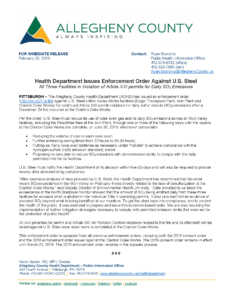
SUMMARY: Allegheny County Health Department announces an Enforcement Order against U.S. Steel for violations of air permits.
27. U.S. Steel’s Ninth Mitigation Plan Report (February 22, 2019)
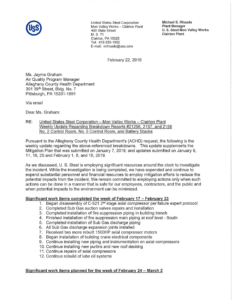
SUMMARY: The Department provides updates on the mitigation plan and repairs at the facility.
The company describes repair work for the week. However, it is still burning some coke oven gas without undergoing control in the desulfurization plant. Compared with the previous week, there is no decrease in the percentages of current operating fuel usage of coke oven gas, according to the table on pages 3-4. There is no change in the length of coking times this week.
26. U.S. Steel’s Eighth Mitigation Plan Report (February 15, 2019)
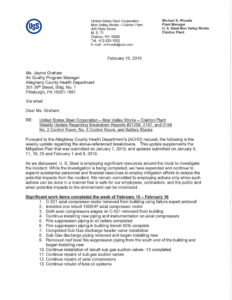
SUMMARY: The Department provides updates on the mitigation plan and repairs at the facility.
The company describes repair work for the week. However, it is still burning some coke oven gas without undergoing control in the desulfurization plant. Compared with the previous week, there is no decrease in the percentages of current operating fuel usage of coke oven gas, according to the table on pages 3-4. There is no change in the length of coking times this week.
25. Press Release: Health Department Weekly Update Regarding Mon Valley Air Quality (February 13, 2019)

SUMMARY: Health Department announces this will be last weekly update and that "there is no need for Mon Valley residents to take specific precautions":
"There is also no update on the repairs to the Clairton Coke Works in the past week, as the plant’s work based on their prior briefings is ongoing. The department continues to monitor daily progress and, as previously noted, U.S. Steel is providing information regarding repairs of the plant on its website: http://www.clairton.uss.com.
As there is no additional news at this time, this will be the last ACHD weekly update. If there are ongoing, emerging issues to be addressed, those will be done immediately by the department via press release, social media post on the Health Department’s Facebook page, and through Allegheny Alerts messages to subscribers.
As a reminder, there is no need for Mon Valley residents to take specific precautions. The Health Department continues to remind sensitive populations across the county, particularly those with existing respiratory conditions, that they may need to limit their outdoor activities when air quality is deemed unhealthy for sensitive groups. As the department has been doing, the daily update regarding SO2 status in the Mon Valley provided each day at 3 p.m. will continue."
24. PennEnvironment and Clean Air Council Notice of Intent to Sue U.S. Steel (February 13, 2019)
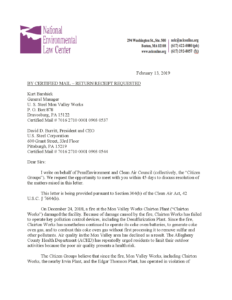
SUMMARY: 60-day notice letter from PennEnvironment and Clean Air Council sets forth terms and conditions of the Title V permit that have been violated or may have been violated as a result of the continuing combustion of coke oven gas without controls in the desulfurization plant, since December 24, 2018.
23. Press Release: PennEnvironment, Clean Air Council will sue U.S. Steel for Clean Air Act Violations at Mon Valley Works (February 13, 2019)
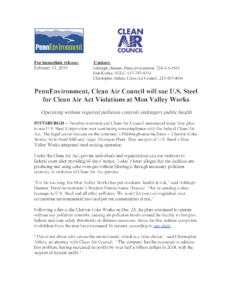
SUMMARY: Environmental organizations PennEnvironment and Clean Air Council provide 60-day notice to U.S. Steel and environmental agencies that they will sue the company for noncompliance with its Title V permit.
22. U.S. Steel’s Seventh Mitigation Plan Report (February 8, 2019)
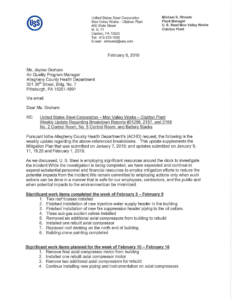
SUMMARY: The Department provides updates on the mitigation plan and repairs at the facility.
The company describes repair work for the week. However, it is still burning some coke oven gas without undergoing control in the desulfurization plant. Compared with the previous week, there is no decrease in the percentages of current operating fuel usage of coke oven gas, according to the table on pages 3-4. There is no change in the length of coking times this week.
21. Mark Dixon/Blue Lens (Filmmaker), Testimony at Democratic Policy Committee Hearing in Clairton (February 7, 2019)
a. Testimony of Matt Mehalik, Executive Director of the Breathe Project (11:50)
b. Testimony of Ashleigh Deemer, Western PA Director of PennEnvironment (7:27)
c. Testimony of Dr. Deborah Gentile (15:01)
d. Testimony of Rachel Filippini, Executive Director of Group Against Smog and Air Pollution (7:56)
20. Senate and House Democratic Policy Committees Hearing in Clairton (February 8, 2019)
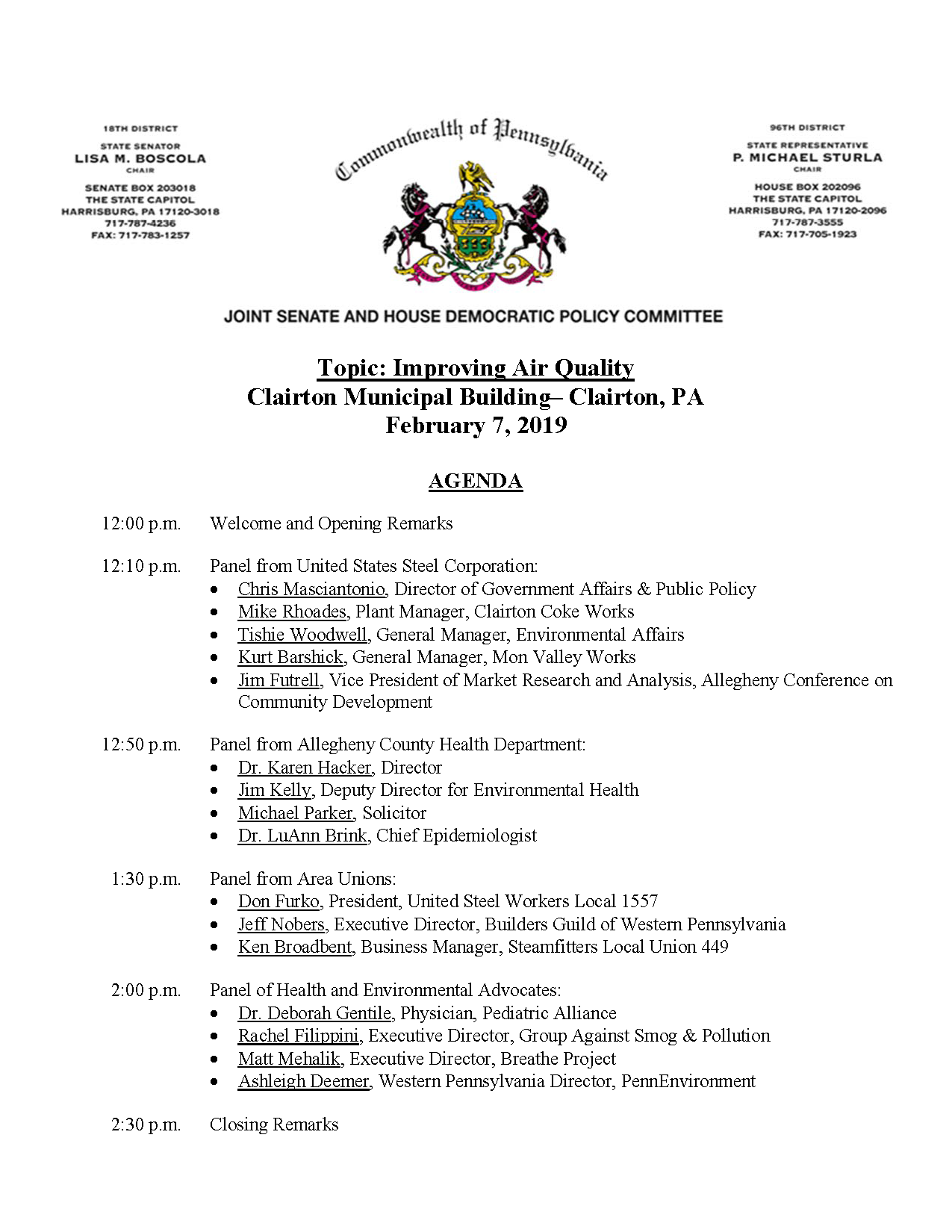
SUMMARY: Representatives of U.S. Steel, the Allegheny County Health Department, unions, and health and environmental advocates provide testimony at a policy hearing before the joint committee. Written testimony is available through this link.
19. Press Release: February 6 Update on Mon Valley Air Quality and Status of Clairton Coke Work Repairs (February 6, 2019)
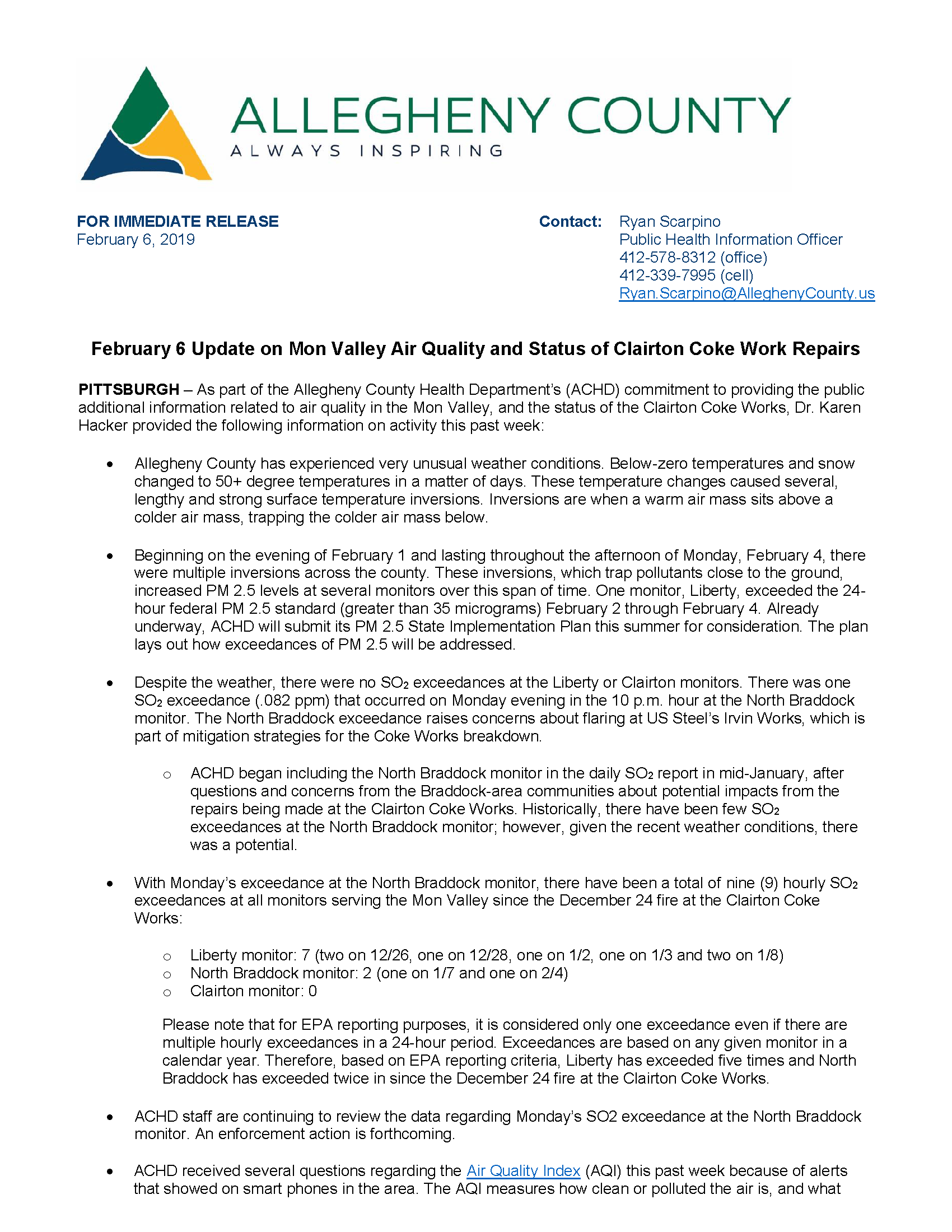
SUMMARY: Health Department provides an update on the air inversion incident over the weekend, resulting in exceedances of the daily standard for fine particulates, along with other information.
"Beginning on the evening of February 1 and lasting throughout the afternoon of Monday, February 4, there were multiple inversions across the county. These inversions, which trap pollutants close to the ground, increased PM 2.5 levels at several monitors over this span of time. One monitor, Liberty, exceeded the 24-hour federal PM 2.5 standard (greater than 35 micrograms) February 2 through February 4. Already underway, ACHD will submit its PM 2.5 State Implementation Plan this summer for consideration. The plan lays out how exceedances of PM 2.5 will be addressed.
• Despite the weather, there were no SO2 exceedances at the Liberty or Clairton monitors. There was one SO2 exceedance (.082 ppm) that occurred on Monday evening in the 10 p.m. hour at the North Braddock monitor. The North Braddock exceedance raises concerns about flaring at US Steel’s Irvin Works, which is part of mitigation strategies for the Coke Works breakdown."
18. U.S. Steel’s Sixth Mitigation Plan Report (February 1, 2019)
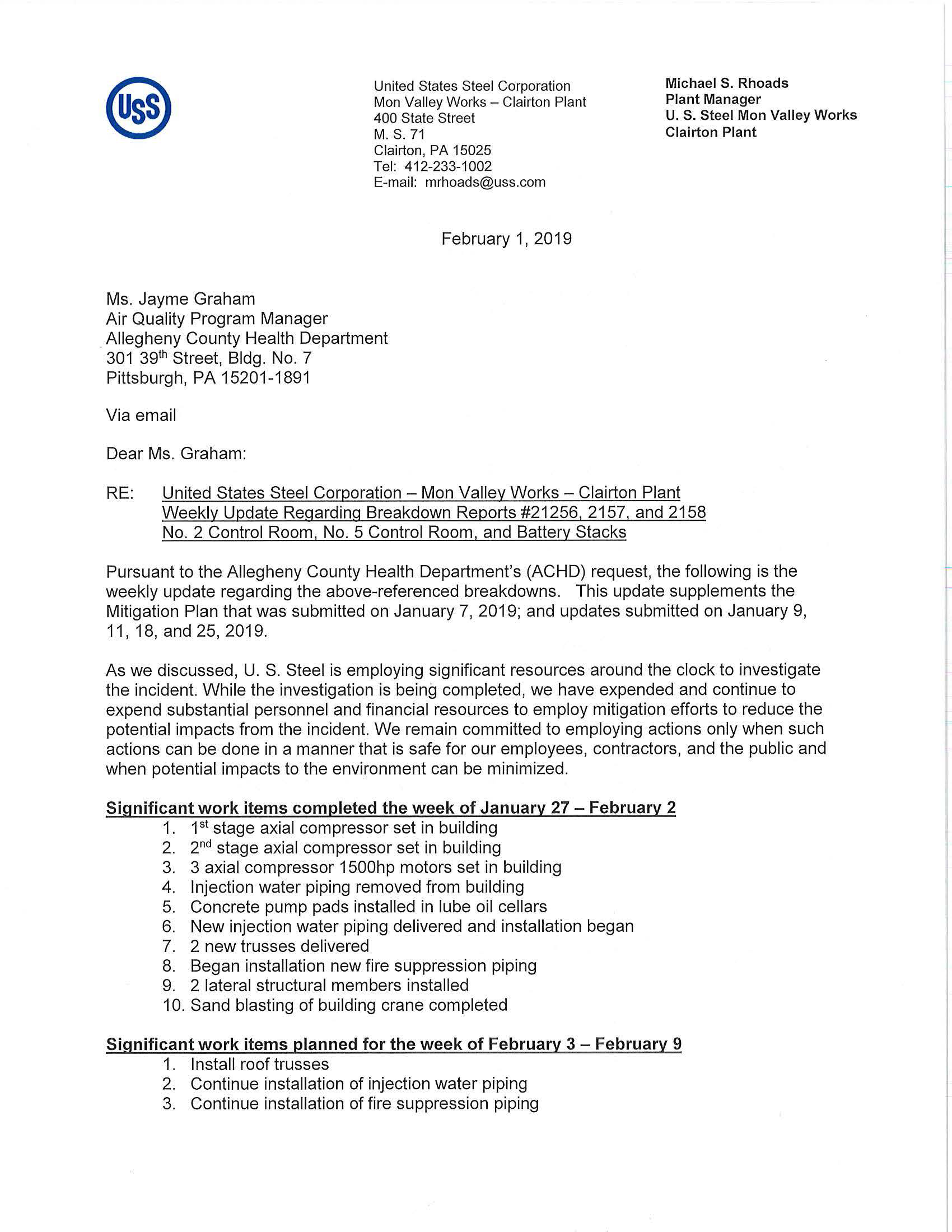
SUMMARY: The company provides updates on the mitigation plan and repairs at the facility.
The company describes its increased efforts to expand coking time. However, it is still burning some coke oven gas without undergoing control in the desulfurization plant. Compared with the previous week, there is no decrease in the percentages of current operating fuel usage of coke oven gas, according to the table on pages 3-4.
"On January 25, we increased 19 and 20 Batteries to 24 hours. On January 28, we increased 19 and 20 again, to 26 hours. We continue to monitor the battery and environmental performance." (page 3).
17. Press Release: Weekly Update on Mon Valley Air Quality, Status of Clairton Coke Works (January 30, 2019)
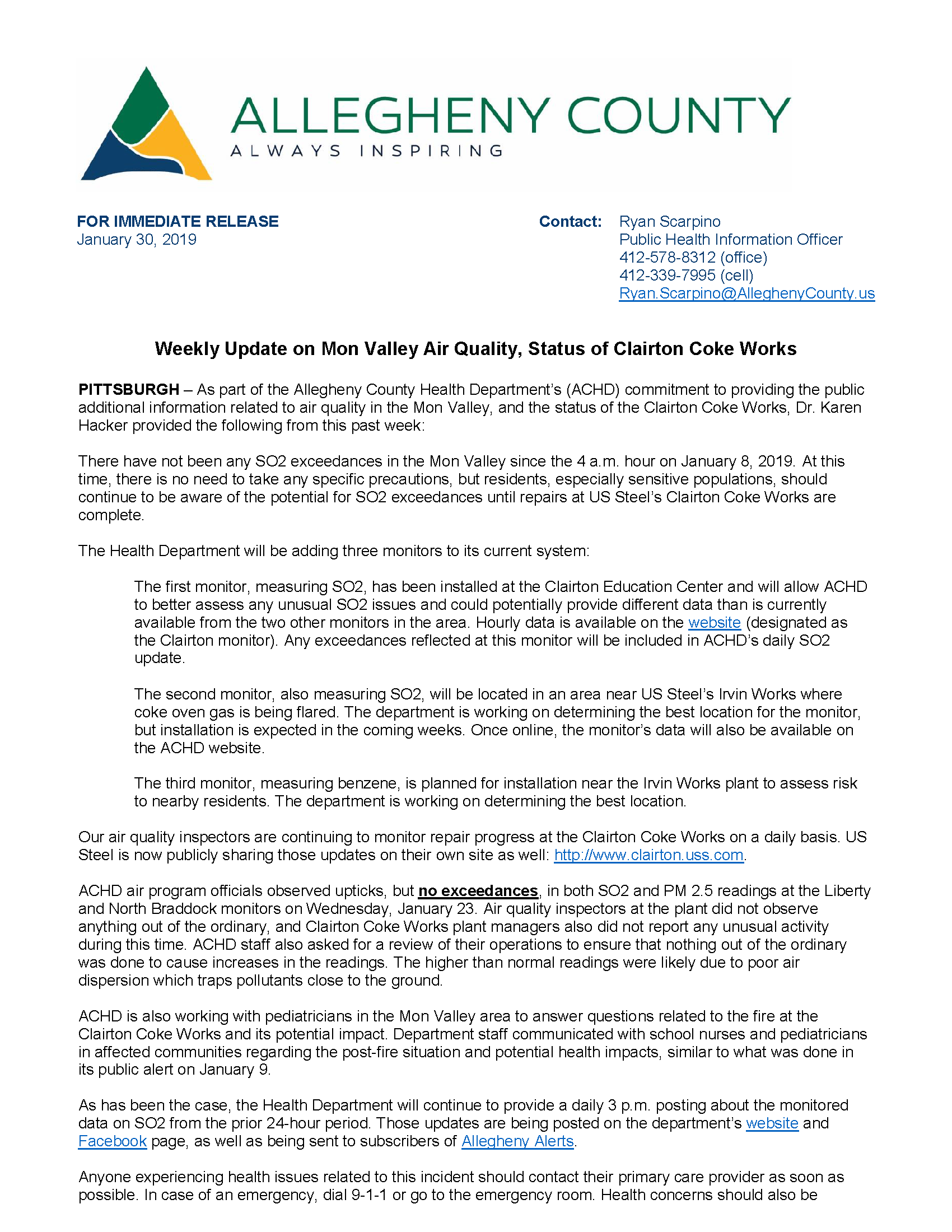
SUMMARY: Health Department provides an update on the installation of new monitors to the monitoring network, along with other information:
"The Health Department will be adding three monitors to its current system:
The first monitor, measuring SO2, has been installed at the Clairton Education Center and will allow ACHD to better assess any unusual SO2 issues and could potentially provide different data than is currently available from the two other monitors in the area. Hourly data is available on the website (designated as the Clairton monitor). Any exceedances reflected at this monitor will be included in ACHD’s daily SO2 update.
The second monitor, also measuring SO2, will be located in an area near US Steel’s Irvin Works where coke oven gas is being flared. The department is working on determining the best location for the monitor, but installation is expected in the coming weeks. Once online, the monitor’s data will also be available on the ACHD website.
The third monitor, measuring benzene, is planned for installation near the Irvin Works plant to assess risk to nearby residents. The department is working on determining the best location."
16. Press Release: United States Steel Corporation Reports Fourth Quarter and Full-Year 2018 Results (January 30, 2019), https://www.sec.gov/Archives/edgar/data/
SUMMARY: the company issues a press release reporting adjusted net earnings of $957 million in 2018, up from $341 million in 2017. This is attached to a filing with the Securities and Exchange Commission: Form 8-K (January 30, 2019), Filing Detail
"United States Steel Corporation (NYSE: X) reported full-year 2018 net earnings of $1,115 million, or $6.25 per diluted share. Adjusted net earnings were $957 million, or $5.36 per diluted share. This compares to a full-year 2017 net earnings of $387 million, or $2.19 per diluted share. Adjusted net earnings for 2017 was $341 million, or $1.94 per diluted share.Fourth quarter 2018 net earnings were $592 million, or $3.34 per diluted share. Adjusted net earnings for the fourth quarter 2018 were $324 million, or $1.82 per diluted share. This compares to a fourth quarter 2017 net earnings of $159 million, or $0.90 per diluted share. Fourth quarter 2017 adjusted net earnings were $136 million, or $0.76 per diluted share.
"We are pleased with both the strong earnings we reported in 2018 and the important progress we made on our strategic objectives," said U. S. Steel President and Chief Executive Officer David B. Burritt. "We are encouraged by the effectiveness of the investments we are making and remain focused on improving our operating and commercial performance to drive long-term value creation for our stockholders."
The Company currently expects first quarter 2019 adjusted EBITDA to be approximately $225 million, which excludes the expected first quarter impacts of the December 24, 2018 fire at our Clairton coke making facility."
15. Senate Democratic Policy Committee of the Pennsylvania House of Representatives: Public Hearing: Improving Air Quality,
http://www.pahouse.com/PolicyCommittee/events
SUMMARY: Committee announces that the Pennsylvania House of Representatives will conduct a hearing on air quality on February 7:
"State Rep. Austin Davis and the Senate Democratic Policy Committee will host a joint hearing on Improving Air Quality.
The hearing will be held at noon, Thursday, February 7 at the Clairton Municipal Building, Council Chambers, 551 Ravensburg Blvd., Clairton, PA 15025."
14. Press Conference of Residents of Clairton and the Mon Valley (January 23, 2019)
a. Press Release: Clairton Residents Speak Out Against U.S. Steel’s Failed Response on Clairton Coke Works Pollution (January 23, 2019)
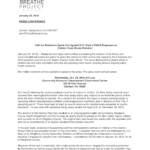
SUMMARY: Breathe Project notes that residents of Clairton and the Mon Valley are calling on the Allegheny County Health Department to order the coke works to be placed in hot idle until pollution control equipment can be brought back on line. (page 2).
Residents of Clairton and the Mon Valley issue the following statements:
“People in my community are tired mentally, physically and spiritually of the health impacts of this plant,” said Melanie Meade, a life-long resident and mother in Clairton. “U.S. Steel is not following the law. Clairton is the Love Canal of Pennsylvania.” (page 2).
“People in Clairton have had ear and sinus problems for weeks that started around this time,” said Cheryl Hurt, a life-long resident who runs a daycare for children in Clairton. “How would U.S. Steel feel if they lived here and weren’t informed about this situation? The children and the elderly were not taken into consideration.” (page 2).
"The odors from the plant have been more noxious than ever. Last week, it was so bad that I thought something in my house was burning," said Michael Meighan of East Pittsburgh, who has lived in the Mon Valley for 15 years. "It seems that fines are not enough to convince U.S. Steel’s Clairton Coke Works to make the necessary repairs. The Allegheny County Health Department should force them to hot idle until the problem has been fixed.” (page 2).
“I fear that health protections are not rising as the top priority for those of us who live in the affected communities,” said Lisa Graves Marcucci, speaking on behalf of herself and her family in West Mifflin, Pleasant Hills and Jefferson Hills, all life-long residents of the Mon Valley. “More must be done to hold U.S. Steel accountable for the serious pollution releases and that accountability must focus on health and not the company’s bottom line.” (page 2).
b. Clean Air Council Video, Press Conference of Residents of Clairton and the Mon Valley, (January 23, 2019) (video running time 01:25:20)

SUMMARY: Residents of the Monongahela Valley hold a press conference to discuss their reaction to the Clairton fire and its aftermath.
13. Press Release: Hacker Weekly Update on Clairton Coke Works Repairs and Air Quality in Mon Valley (January 23, 2019)
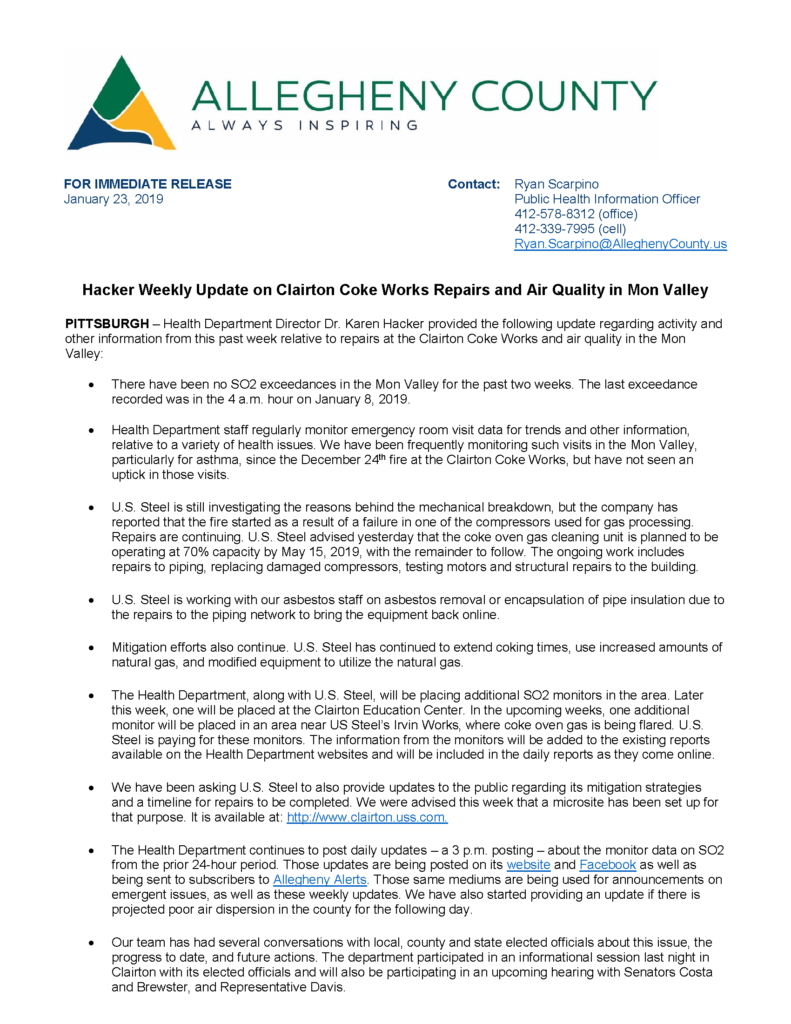
SUMMARY: Health Department provides an update on repairs at the facility:
“U.S. Steel advised yesterday that the coke oven gas cleaning unit is planned to be operating at 70% capacity by May 15, 2019, with the remainder to follow.” (page 1).
“The Health Department, along with U.S. Steel, will be placing additional SO2 monitors in the area. Later this week, one will be placed at the Clairton Education Center. In the upcoming weeks, one additional monitor will be placed in an area near US Steel’s Irvin Works, where coke oven gas is being flared. U.S. Steel is paying for these monitors. The information from the monitors will be added to the existing reports available on the Health Department websites and will be included in the daily reports as they come online.” (page 1).
“Last week, we had the opportunity to provide feedback to the PA Department of Environmental Protection as well as to staff in the PA House of Representatives as to legislative action could be taken to provide additional tools and resources, including enforcement and monitoring capabilities, to the Health Department moving forward. We are hopeful that those conversations will result in legislation being introduced in the near future.” (page 2).
“Once the repair work is completed and the Health Department can evaluate this incident, US Steel faces civil penalties for permit and Article XXI Air Pollution Control violations.” (page 2).
12. Mark Dixon, Filmmaker, Video, City of Clairton “Situational Awareness Meeting” (Re: Clairton Coke Works fire on 12/24/18) (January 22, 2019),
https://www.facebook.com/ (video running time 01:26:20)
SUMMARY: "This meeting on 1/22/19 addresses issues related to the fire accident at Clairton Coke Works that took place on 12/24/18."
This Facebook page provides the following links to photographs of slides showing some of the damage to the facility, presented at the event:
https://www.facebook.com/media/set/(smaller photographs)
https://www.flickr.com/photos/ (larger photographs)
11. U.S. Steel’s Fifth Mitigation Plan Report (January 25, 2019)
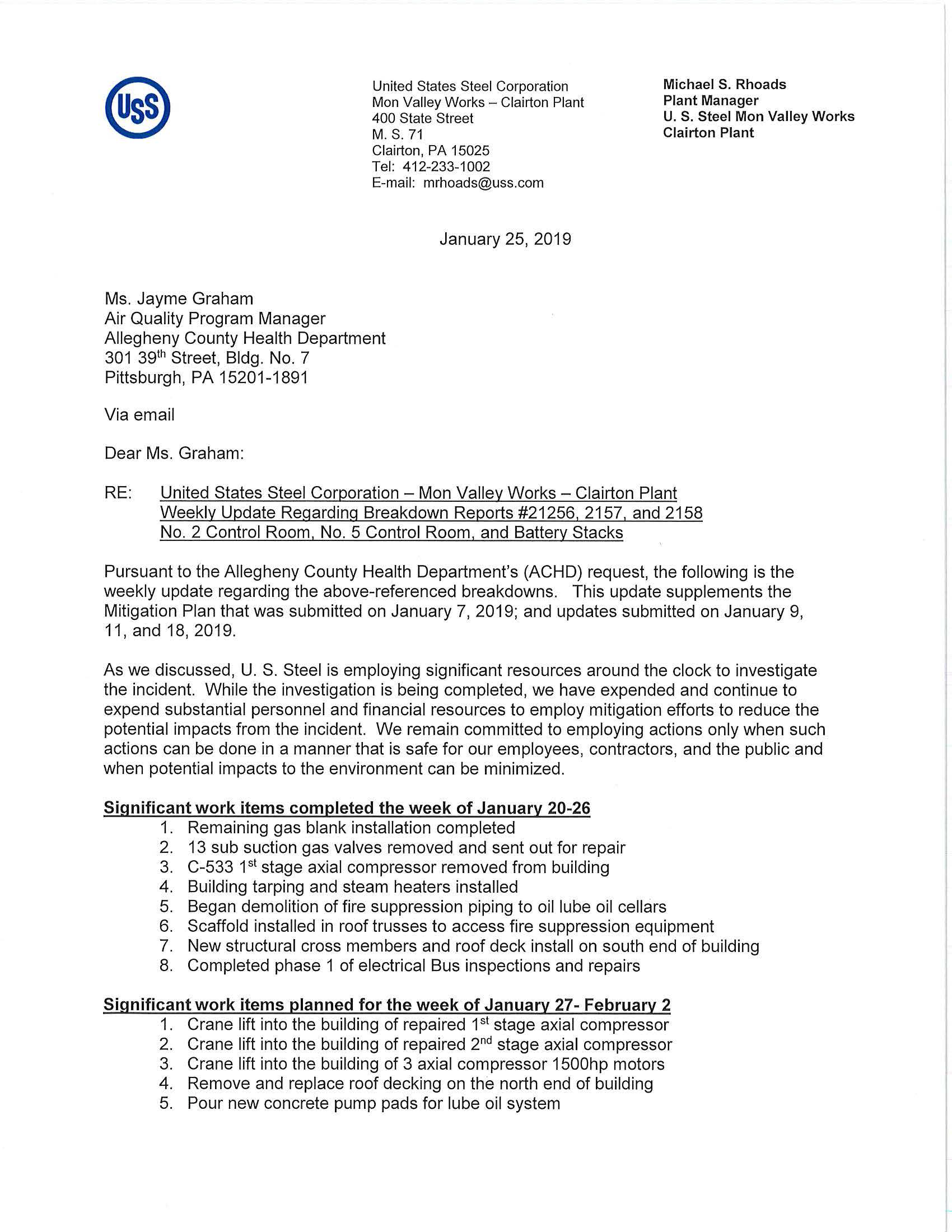
SUMMARY: The company provides updates on the mitigation plan and repairs at the facility.
The company describes its increased efforts to expand coking time. However, it is still burning some coke oven gas without undergoing control in the desulfurization plant. Compared with the previous week, there is no decrease in the percentages of current operating fuel usage of coke oven gas, according to the table on pages 3-4.
"On January 25, we increased 19 and 20 Batteries to 24 hours as an additional mitigation measure. We continue to monitor the battery and environmental performance."
10. U.S. Steel’s Fourth Mitigation Plan Report (January 18, 2019)
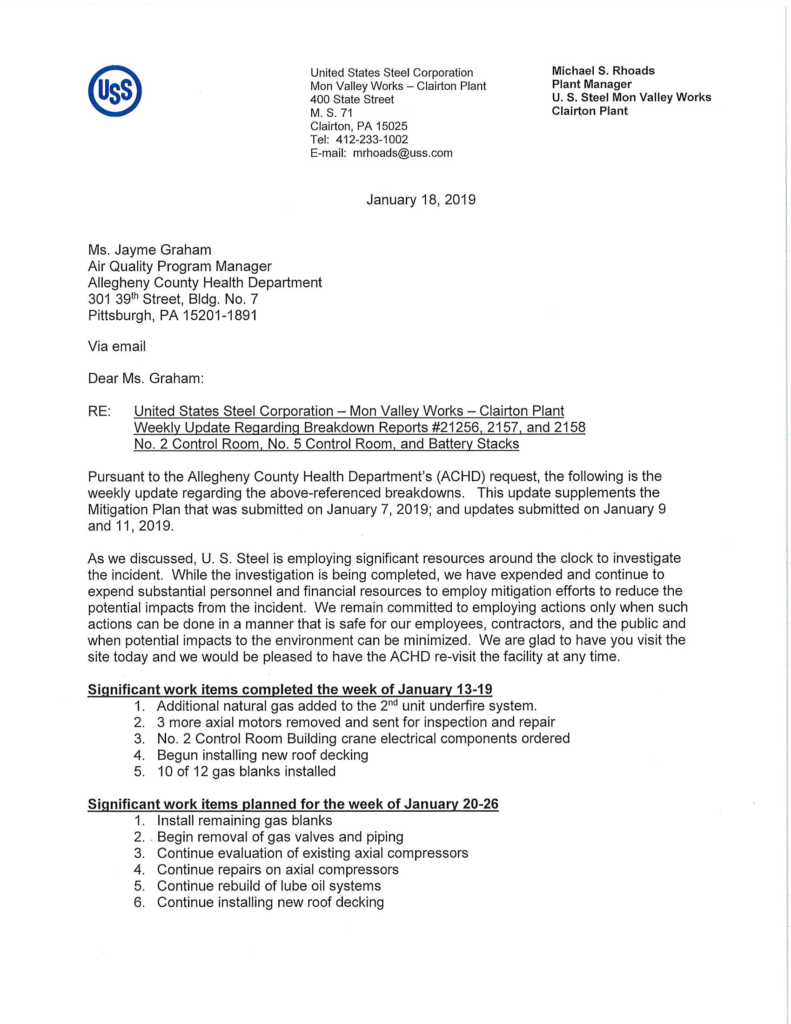
SUMMARY: The company provides updates on the mitigation plan and repairs at the facility.
The company describes its increased efforts to partially substitute natural gas for coke oven gas. However, it is still burning some coke oven gas without undergoing control in the desulfurization plant. On page 3, the company sets forth a table identifying the percentage of current operating fuel usage of coke oven gas, for individual emissions units.
“To date, among other efforts, we have utilized natural gas (displacing coke oven gas) to the extent practicable.” (page 2).
“Please note that on January 14, 2019, we increased the coking time on Batteries 1, 2, and 3 from 22 hours to 23 hours. On January 17, we increased C Battery coking time from 20 to 21 hours, and on January 15, we increased 20 Battery coking time from 22.5 to 23.5 hours as an additional mitigation measure. We continue to monitor the battery and environmental performance.” (pages 2-3).
“As noted above, since our January 9, 2019 update, we increased the use of natural gas to offset coke oven gas at the Irvin Hot Strip Mill. In addition, on January 10, 2019, we increased the use of natural gas on Clairton Boiler No. 1. Clairton underfire natural gas percentage increased from 40% to 60%. We continue to monitor these efforts.” (page 4).
9. Press Release: Sens. Costa, Brewster & Rep. Davis Calls for Immediate Action at Clairton Coke Works (January 17, 2019),
http://www.senatorcosta.com/sens-costa-brewster-rep-davis-calls-for-immediate-action-at-clairton-coke-works/
SUMMARY: State Senator Jay Costa calls for action regarding the aftermath of the Clairton fire.
“[W]e are calling for:
1. The Senate and House Democratic Policy Committees to hold a joint hearing in the effected communities to hear from US Steel officials, the Allegheny County Department of Health, local public health and environmental advocates, and members of the community;
2. Complete transparency about daily emissions from the Clairton plant, the planned resolution for repairing the plant from the fire including specific timelines, and in the near future, specifics on how the longer-term emissions problems are going to be addressed; and
3. To get to the bottom of the legal confusion causing delays in important public health notifications. The public needs to know sooner and get better information on how to react.”
8. Audio of Interview of Jim Kelly, Deputy Director for Environmental Health of the Allegheny County Health Department (January 17, 2019)
LISTEN: Jim Kelly sits down with 90.5 WESA to discuss the Clairton Coke Works fire and subsequent air quality issues. (click on the link relating to Artist Kamara Townes, and listen at 13:30)
https://itunes.apple.com/us/podcast/artist-kamara-townes-takes-page-from-warhol-using-colorful/
7. Press Release: Health Department Update on Clairton Coke Works Repairs and Air Quality in Mon Valley (January 16, 2019)
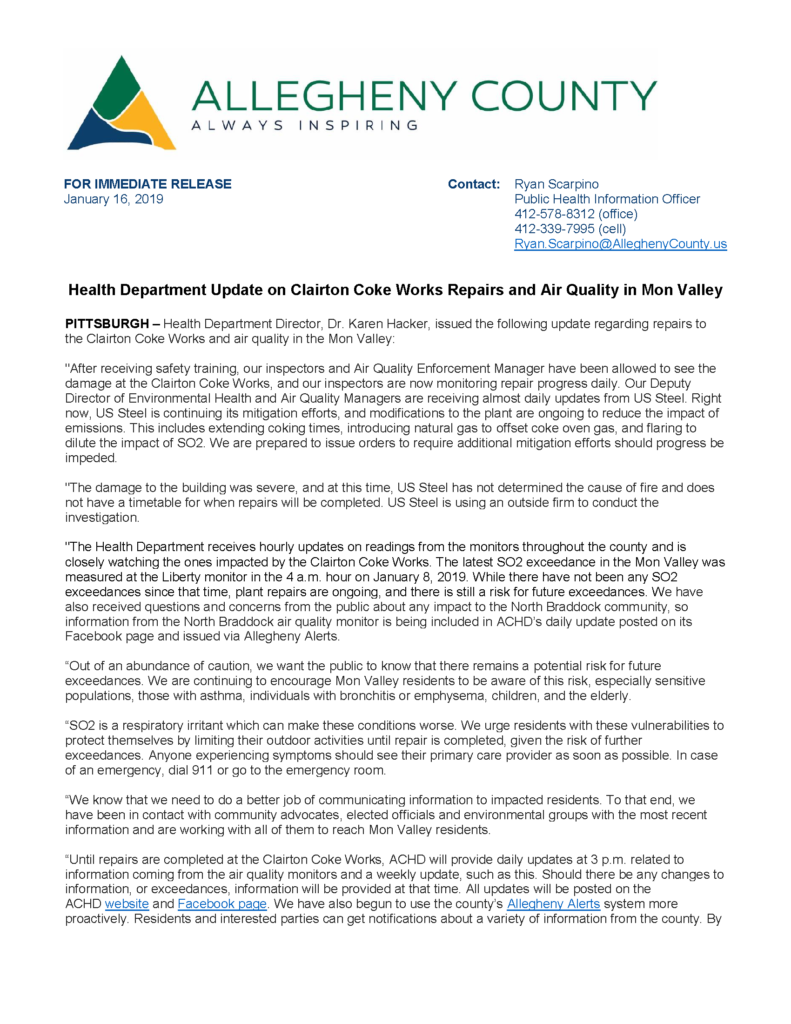
SUMMARY: The Health Department provides an update on repairs at the facility:
“Right now, US Steel is continuing its mitigation efforts, and modifications to the plant are ongoing to reduce the impact of emissions. This includes extending coking times, introducing natural gas to offset coke oven gas, and flaring to dilute the impact of SO2. We are prepared to issue orders to require additional mitigation efforts should progress be impeded." (page 1).
"The damage to the building was severe, and at this time, US Steel has not determined the cause of fire and does not have a timetable for when repairs will be completed. US Steel is using an outside firm to conduct the investigation." (page 1).
"The Health Department receives hourly updates on readings from the monitors throughout the county and is closely watching the ones impacted by the Clairton Coke Works. The latest SO2 exceedance in the Mon Valley was measured at the Liberty monitor in the 4 a.m. hour on January 8, 2019. While there have not been any SO2 exceedances since that time, plant repairs are ongoing, and there is still a risk for future exceedances.” (page 1).
6. U.S. Steel’s Third Mitigation Plan Report (January 11, 2019)
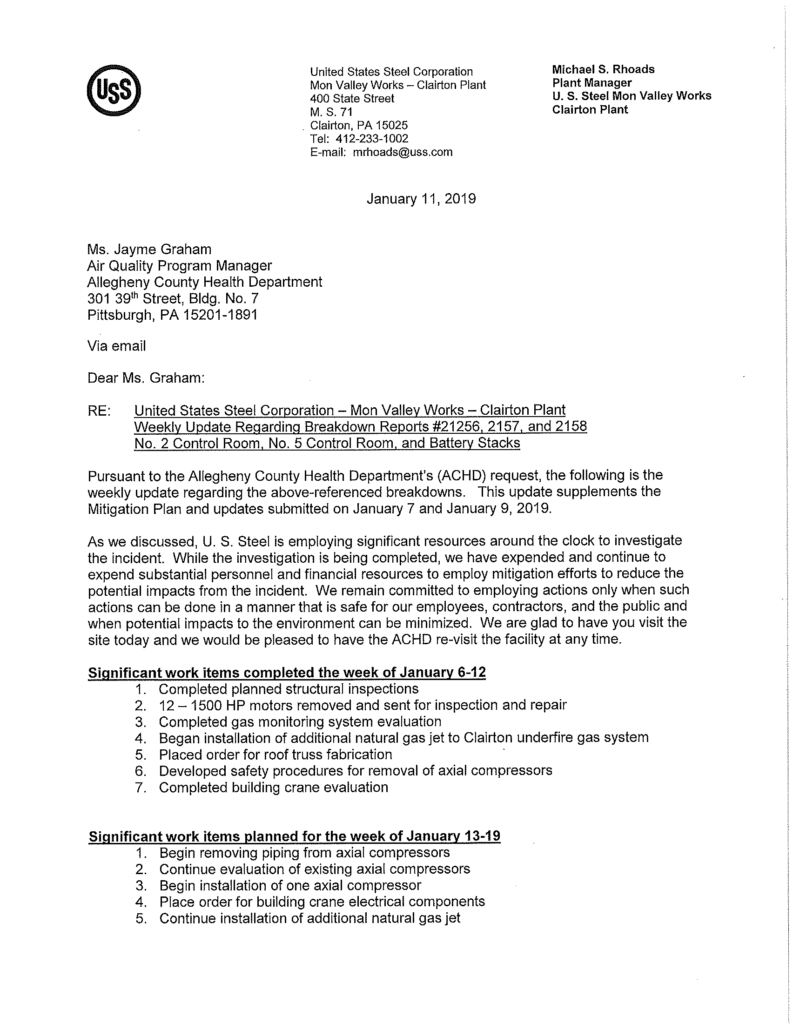
SUMMARY: The company provides updates on the mitigation plan and repairs at the facility.
The company describes its increased efforts to partially substitute natural gas for coke oven gas. However, it is still burning some coke oven gas without undergoing control in the desulfurization plant. The emissions units experiencing a decrease in percentage of usage of coke oven gas are the Clairton No. 1 boiler (down from 10-20% to 5-10%) and Irvin Hot Strip Mill (down from 50-60% to 10-20%). (page 4, table).
"Please note that on January 11, 2019, we increased the coking time on Batteries 13, 14, and 15 from 21. 5 hours to 22 hours as an additional mitigation measure. We continue to monitor the battery and environmental performance."
“As noted above, since our January 9, 2019 update, we increased the use of natural gas to offset coke oven gas at the Irvin Hot Strip Mill. In addition, on January 10, 2019, we increased the use of natural gas on Clairton Boiler No. 1. Clairton underfire natural gas percentage increased from 40% to 60%. We continue to monitor these efforts.” (page 4).
5. Press Release: ACHD Provides Additional Detail on Recent Mon Valley Air Quality Issues (January 10, 2019)
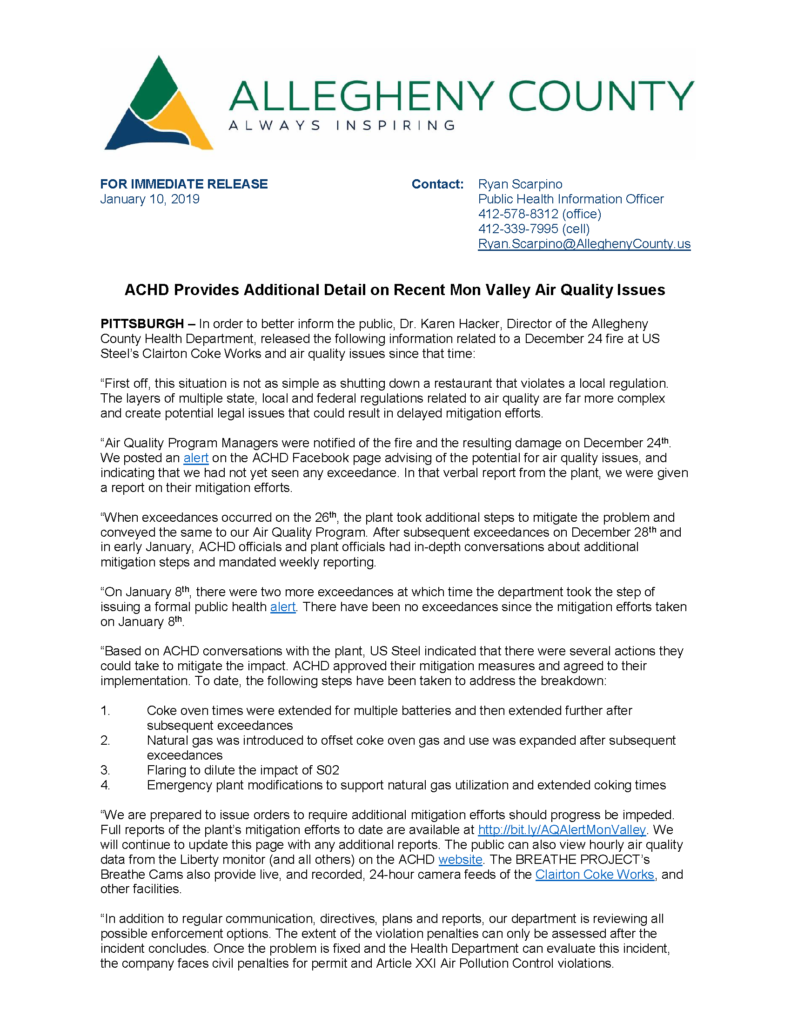
SUMMARY: The Health Department identifies at least four days when there were exceedences of the SO2 standard:
“When exceedances occurred on the 26th, the plant took additional steps to mitigate the problem and conveyed the same to our Air Quality Program. After subsequent exceedances on December 28th and in early January, ACHD officials and plant officials had in-depth conversations about additional mitigation steps and mandated weekly reporting.
On January 8th, there were two more exceedances at which time the department took the step of issuing a formal public health alert. There have been no exceedances since the mitigation efforts taken on January 8th.”
In addition, the Department set forth a summary of the mitigation efforts undertaken by U.S. Steel:
“To date, the following steps have been taken to address the breakdown:
1. Coke oven times were extended for multiple batteries and then extended further after subsequent exceedances
2. Natural gas was introduced to offset coke oven gas and use was expanded after subsequent exceedances
3. Flaring to dilute the impact of SO2
4. Emergency plant modifications to support natural gas utilization and extended coking times.” (page 1).
4. U.S. Steel’s Second Mitigation Plan Report (January 9, 2019)
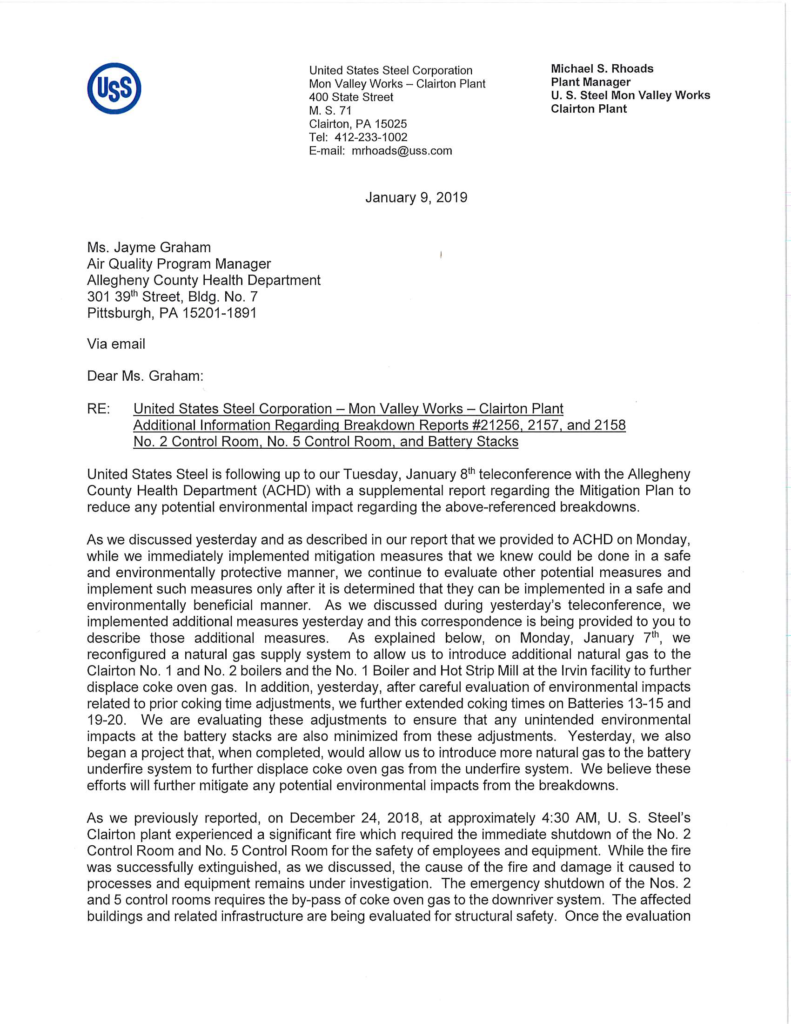
SUMMARY: The company provides updates on the mitigation plan and repairs at the facility.
The company describes its increased efforts to partially substitute natural gas for coke oven gas. However, it is still burning some coke oven gas without undergoing control in the desulfurization plant.
The emissions units experiencing a decrease in percentage of usage of coke oven gas arethe Clairton No. 1 boiler and Clairton No. 2 boiler (down from 50-60% to 10-20%). (page 4, table).
“... we reconfigured a natural gas supply system to allow us to introduce additional natural gas to the Clairton No. 1 and No. 2 boilers and the No. 1 Boiler and Hot Strip Mill at the Irvin facility to further displace coke oven gas.” (page 1)
“… we further extended coking times on Batteries 13-15 and 19-20.” (page 1)
“… we also began a project that, when completed, would allow us to introduce more natural gas to the battery underfire system to further displace coke oven gas from the underfire system.” (page 1)
“As we discussed, we understand ACHD's expectation that U. S. Steel consider additional mitigation steps in the event data indicate that such measures are warranted.
We are investigating other mitigation steps to be taken including:
1. Continue to evaluate processes and operations to identify ways to minimize environmental impact and ensure battery integrity and stack compliance.” (page 2).
“Please note that on January 14, 2019, we increased the coking time on Batteries 1, 2, and 3 from 22 hours to 23 hours. On January 17, we increased C Battery coking time from 20 to 21 hours, and on January 15, we increased 20 Battery coking time from 22.5 to 23.5 hours as an additional mitigation measure. We continue to monitor the battery and environmental performance.” (pages 2-3).
3. Press Release: Mon-Valley Residents Urged to Limit Outdoor Activities Due to Air Quality Concerns (January 9, 2019)
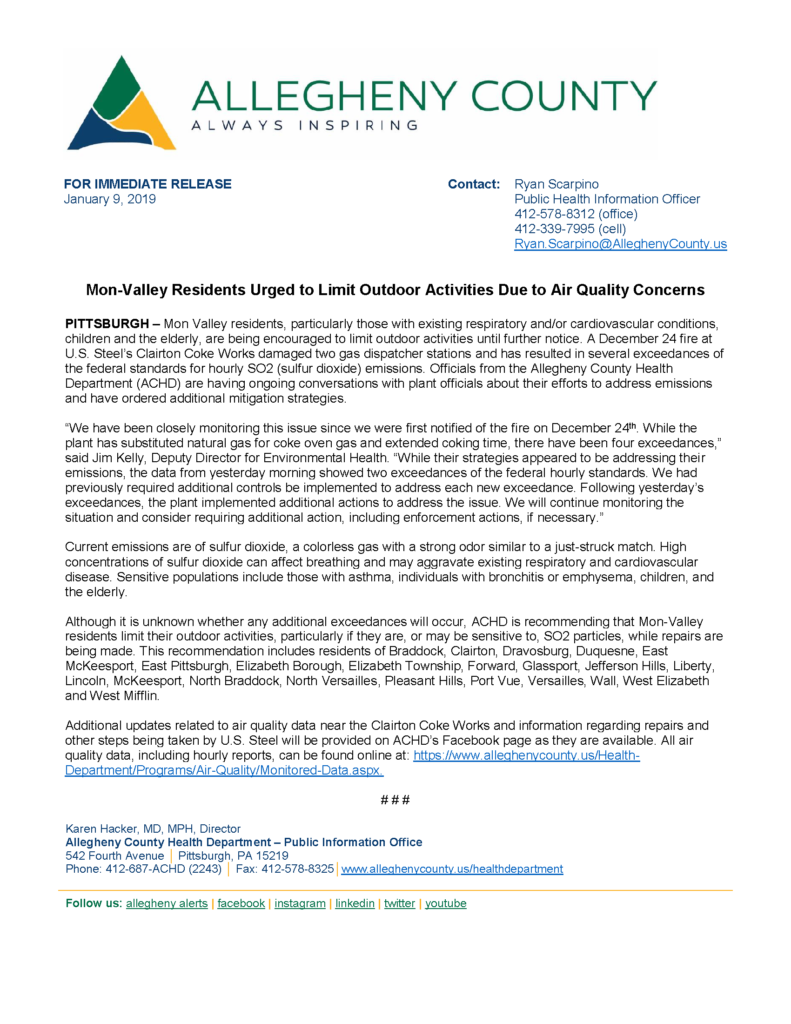
SUMMARY: The Health Department encourages Mon Valley residents, particularly those with existing respiratory and/or cardiovascular conditions, children and the elderly, to limit outdoor activities until further notice.
The Department notes that following the fire, there were several exceedances of the federal standards for hourly SO2 emissions.
Its recommendation relates to residents of Braddock, Clairton, Dravosburg, Duquesne, East McKeesport, East Pittsburgh, Elizabeth Borough, Elizabeth Township, Forward, Glassport, Jefferson Hills, Liberty, Lincoln, McKeesport, North Braddock, North Versailles, Pleasant Hills, Port Vue, Versailles, Wall, West Elizabeth and West Mifflin.
2. U.S. Steel’s First Mitigation Plan Report (January 7, 2019)
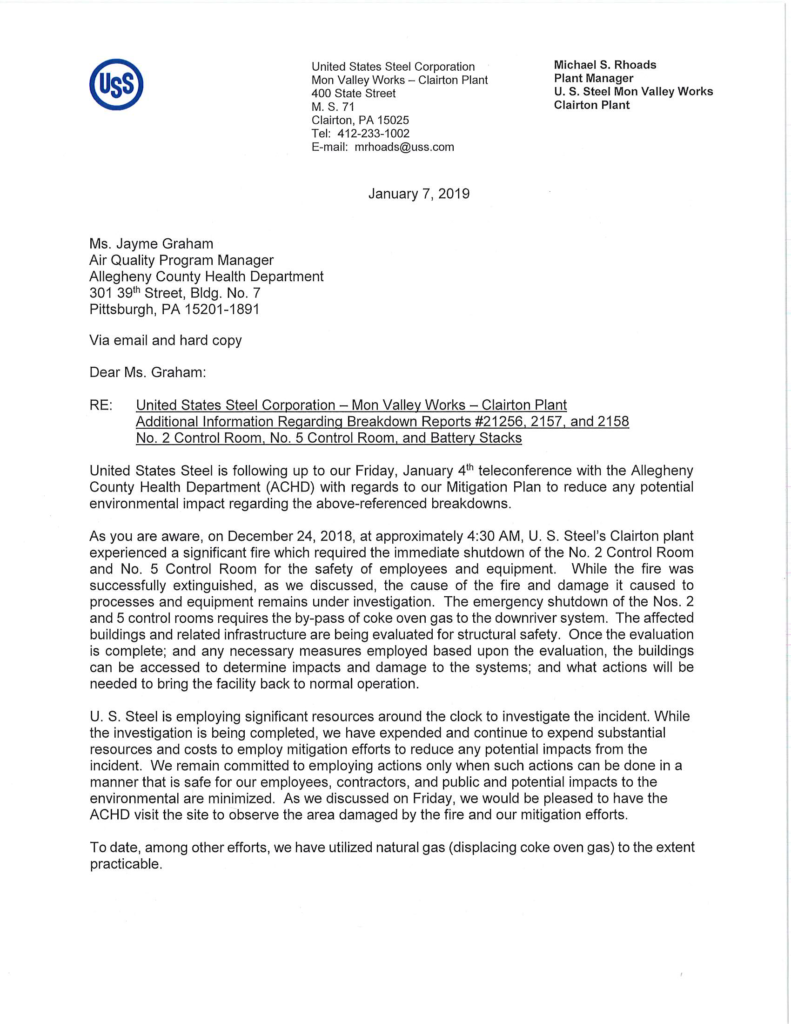
SUMMARY: The company describes the diversion of coke oven gas away from the desulfurization plant associated with the No. 5 control room, as well as its effort to mitigate the problem by partially substituting natural gas for coke oven gas. On pages 6-7, the company sets forth a table identifying the percentage of current operating fuel usage of coke oven gas. Coke oven gas continues to be burned without undergoing the desulfurization process:
“To date, among other efforts, we have utilized natural gas (displacing coke oven gas) to the extent practicable.” (page 1).
“The emergency shutdown of the Nos. 2 and 5 control rooms requires the by-pass of coke oven gas to the downriver system.” (page 1)
“This carbonate feed gas stream is sent on to the #5 control room for sulfur removal. Once the sulfur has been removed from the carbonate feed gas, this gas is combined with the clean downriver gas, for downstream consumption.
Without the #2 Control room operation, the facility cannot operate the #5 control room process, because the operation of #2 control room is critical to separate and concentrate the acid gas components in the coke oven gas stream into a small fraction of the coke oven gas (15% of the total volume). The piping does not exist to go from #1 control room directly to #5 control room. In addition, #5 control room is not sized to handle this full flow of coke oven gas.” (page 2)
1. Coverage of the Fire and the Immediate Response (December 24, 2018)
a. Breathe Project, Breathe Cam:
This website provides a video of the fire: http://www.breatheproject.org/learn/breathe-cam/
(set the date and time to December 24, 2018 at 4:00 am, running to about 5:00 am)
b. Pittsburgh Action News 4, Crews respond to fire at US Steel's Clairton plant (December 24, 2018)
The fire was reported by a local television station: https://www.wtae.com/article/crews-respond-to-fire-at-us-steels-clairton-plant/
c. U.S. Steel, Breakdown Reports (December 24, 2018)
SUMMARY: This reports set forth information regarding the nature of the breakdown:
Breakdown Report #1, Breakdown Report #2
d. U.S. Steel, Notice of Outage (December 31, 2018)
(7-Day Letter Required by Section 2108.01 of the county air regulations)
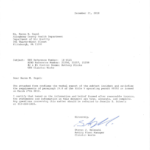
SUMMARY: The company's report sets forth the nature and cause of the breakdown, the identification of resulting emissions, and the mitigation measures being taken:
"A fire occurred which required the immediate shutdown of the #2 & #5 Control Rooms for the safety of the employees and equipment. The cause of the fire remains under investigation. The emergency shutdown of #2 and #5 Control Rooms necessitates the by-pass of coke oven gas to the downriver systems. The affected buildings are being evaluated for structural safety. Once the structural safety evaluation is complete; and any necessary measures employed based upon the evaluation, the buildings can be accessed to determine impacts and damage to the systems; and what actions will be needed to bring the facility back to normal operation. The 35 grain H2S limit was exceeded."
....
"Elevated H2S in the downriver gas line systems, with potential increases of SO2, VOCs, and total reduced sulfur. The breakdown may also cause increases of emissions at coke oven gas combustion sources at Irvin and ET [Edgar Thomson], in addition to Clairton. Clairton combustion stack emission particulate may potentially be elevated beyond those occurring during normal operations."
....
"Measures are being taken to bring the control rooms back on-line and natural gas is being utilized (displacing coke oven gas) to extent practicable during this period."
Background
I. Air Quality Data from Official Air Monitoring Stations
A. Sulfur Dioxide (SO2) (federal standard)
The Liberty monitor measures the concentration of sulfur dioxide in the air.
The national ambient air quality standard is 75 parts per billion (75 ppb). This is practically equivalent to 0.075 parts per million (0.075 ppm). In the hourly data organized by the Department, sulfur dioxide is recorded in parts per million (ppm), which involves moving the decimal three places to the left.
This is an hourly standard. If an hourly concentration is greater than 75 ppb, there is an exceedance of the standard.
Liberty Monitor
Since the Clairton fire, there have been exceedances at the Liberty monitor on 6 days: December 26 (two, maximum 80 ppb)), December 28 (145 ppb), January 2 (81 ppb), January 3 (85 ppb), January 8 (two, maximum 80 ppb), March 28 (82 ppb)
North Braddock Monitor
Since the Clairton fire, there have been exceedances at the North Braddock monitor on 2 days: January 7 (83 ppb) and February 4 (82 ppb)
Clairton Monitor
Starting on January 24, the Department has been reporting data for sulfur dioxide at a new Clairton monitor. There have not been any reported exceedances.
West Mifflin Monitor
Starting on February 21, the Department has been reporting data for sulfur dioxide at a new West Mifflin monitor (the Irvin facility is located in West Mifflin). There have not been any reported exceedances.
This chart summarizes maximum daily concentrations of SO2 at the four monitors:

Sources:
Data from Allegheny County (Excel format): Dec 20-25, Dec 26-31,
Jan 1-4, Jan 5-10, Jan 11-16, Jan 17-22, Jan 23-28, Jan 29-Feb 3,
Feb 4-9, Feb 10-15, Feb 16-21, Feb 22-27, Feb 28-Mar 5
Mar 6-11, Mar 12-17, Mar 18-23, Mar 24-27, Mar 28-29, Mar 30-Apr 4,
Apr 5-10, Apr 11-16, Apr 17-22, Apr 23-28, Apr 29-May 4,
May 5-10, May 11-16, May 17-19, May 19-24, May 25-30, May 31-Jun 5,
Jun 6-11, Jun 12-16, Jun 17-22, Jun 23-28, Jun 29-Jul 4,
Jul 5-10, Jul 11-16, Jul 17-22, July 23-28, Jul 29-Aug 1,
Aug 2-4, Aug 5-10, Aug 11-16, Aug 17-22, Aug 23-28
Aug 29-Sep 3, Sep 4-9, Sep 10-15, Sep 16-21, Sep 22-27, Sep 28-Oct 3,
Oct 4-9, Oct 10-15, Oct 16-21, Oct 22-27, Oct 28-Nov 2,
Nov 3-8, Nov 9-14, Nov 15-20, Nov 21-26, Nov 27-Dec 2,
Dec 3-8, Dec 9-14, Dec 15-20, Dec 21, Dec 22-27, Dec 28-Jan 2,
Jan 3-8, Jan 9-12, Jan 13-18, Jan 19-24, Jan 25-26
B. Hydrogen Sulfide (H2S) (state standard)
There are two state ambient air quality standards for hydrogen sulfide (H2S):
0.005 parts per million (ppm) (averaged over 24-hour period)
0.1 parts per million (ppm) (averaged over 1-hour period)
Source: 25 Pa. Code §131.3
Liberty Monitor
Since the Clairton fire, there have been exceedances at the Liberty monitor on 28 days (all for the 24-hour average of 0.005 ppm: December 26 (0.014 ppm), December 28 (0.008 ppm), January 8 (0.009 ppm), February 2 (0.013 ppm), February 3 (0.022 ppm), February 4 (0.021 ppm), March 19 (0.006 ppm), March 24 (0.009 ppm), March 28 (0.010 ppm), March 29 (0.006 ppm), April 3 (0.008 ppm), April 4 (0.008 ppm), May 6 (0.008 ppm), June 26 (0.007 ppm), June 27 (0.007 ppm), July 2 (0.006 ppm), July 13 (0.008 ppm), September 25 (0.007 ppm), October 14 (0.007 ppm), October 24 (0.007 ppm), October 25 (0.010 ppm), December 21 (0.006 ppm), December 22 (0.009 ppm), December 23 (0.013 ppm), December 24 (0.011 ppm), December 25 (0.009 ppm), December 26 (0.011 ppm), and December 27 (0.006 ppm)
This chart summarizes average and maximum daily concentrations of hydrogen sulfide at the Liberty monitor:

Source: Data from Allegheny County (Excel format): see above
C. Fine Particulates (PM2.5) (federal standard)
The Liberty 2 monitor measures the concentration of fine particulates in the air.
The national ambient air quality standard is 35 micrograms per cubic meter (35 µg/m3). Unlike the sulfur dioxide standard, this is a daily standard that requires the calculation of the average of all hourly concentrations in a calendar day. If this average is greater than 35 µg/m3 is there an exceedance.
Liberty 2 Monitor
Since the Clairton fire, there have been exceedances on 11 days:
February 2 (52 µg/m3 and 65 µg/m3), February 3 (53 µg/m3 and 65 µg/m3), February 4 (53 µg/m3 and 65 µg/m3), March 24 (38 µg/m3), September 11 (41 µg/m3), December 21 (41 µg/m3), December 22 (49 µg/m3), December 23 (57 µg/m3), December 24 (52 µg/m3), December 25 (37 µg/m3), and December 26 (45 µg/m3).
(The two columns in the chart refer to two sensors).
This chart summarizes daily average concentrations of fine particulates at the Liberty monitor:

Sources: Data from Allegheny County (Excel format): see above
D. Graphs of Data for All Three Pollutants (Excel spreadsheets)
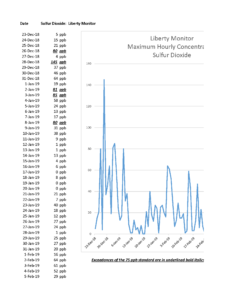
In one document, there are seven spreadsheets and graphs demonstrating the trends for each of these air pollutants at these monitors.
II. U.S. Steel's Title V Permit (March 27, 2012), pages 1, 2, 6, 13, 15, 181-186
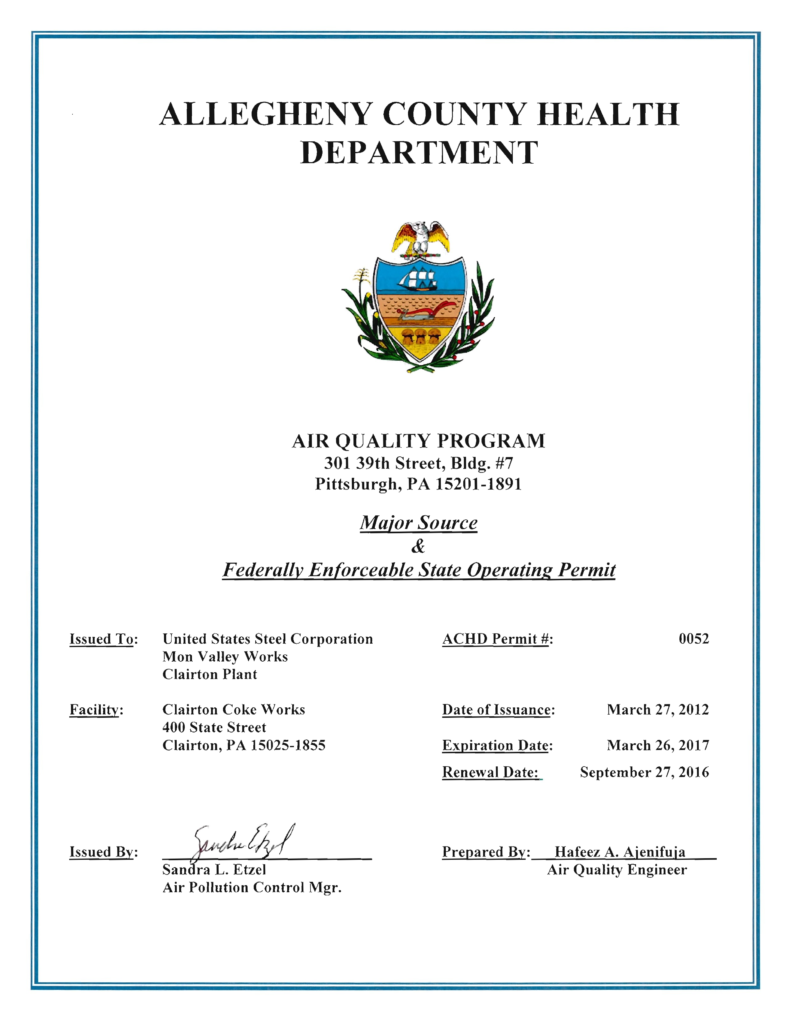
Desulfurization Plant Requirements
The Title V permit for the facility requires U.S. Steel to operate the desulfurization unit when the coke oven gas is produced:
“c. The permittee shall, at all times: [Enforcement Order No. 200, November 18, 1994]
1) Properly maintain two Claus Plants at the coke oven gas desulfurization facility. Each Claus Plant shall be capable of independently processing all of the coke oven gas produced by the coke plant at full production.
2) Operate one Claus Plant when coke oven gas is being produced.”
(Permit condition V.K.1.c.1-2, page 181).
Emissions Limitation Requirements
The Title V permit prohibits U.S. Steel from burning coke oven gas where the concentration of sulfur compounds (measured as H2S, hydrogen sulfide) exceeds certain concentrations:
“The permittee shall not operate, or allow to be operated, any source in such manner that unburned coke oven gas is emitted into the open air. In addition, no person shall flare, mix, or combust coke oven gas, or allow such gas to be flared, mixed, or combusted, unless the concentration of sulfur compounds, measured as hydrogen sulfide, in such gas is less than or equal to the following concentrations: [§2105.21.h]
1) For coke batteries designated 13, 14, 15, 20, and B, a concentration of ten (10) grains per hundred dry cubic feet of coke oven gas;
2) The standard set forth in V.K.1.j.1) above for coke oven batteries designated 13, 14, 15, 20, and B shall be deemed satisfied for such batteries if the coke oven gas from batteries designated 1, 2, 3, 13, 14, 15, 19 , 20 and B and treated by the Clairton Works coke oven gas desulfurization system in existence as of June 24, 1993, has a sulfur compound concentration, measured as H2S, of no greater than 40 grains per hundred dry standard cubic feet of coke oven gas produced by the Clairton Works, when all sulfur emissions from its Claus Sulfur Recovery Plant and the tail gas cleaning equipment thereon, expressed as equivalent H2S, are added to the measured H2S. The concentration of sulfur compounds shall include tail-gas sulfur, measured as hydrogen sulfide, emitted from sulfur removal equipment.”
(Permit condition V.K.1.j., page 184).
Complete permit is available here: Title V Permit (March 12, 2012, 259 pages)
Technical Support Document for Title V Operating Permit (June 14, 2010), page 7
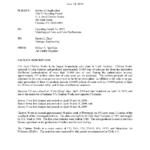
"Desulfurization Plant
After the volatile products in the COG are removed, the COG is processed in the desulfurization plant to remove hydrogen sulfide (H2S) and other sulfur compounds. There are two Claus Plants in the desulfurization plant and one is a backup in the event the primary Claus Plant is out of service. The Claus Plant converts the H2S and other sulfur compounds in the COG to elemental sulfur. The elemental sulfur is sold. The Shell Claus Offgas Treatment (SCOT) Plant separates the gas from the Claus Plant into a concentrated hydrogen sulfide stream and acid offgas. The concentrated hydrogen sulfide stream is sent back to the Claus Plant for further sulfur removal and recovery. The acid offgas is incinerated by the SCOT Plant incinerator. The concentration of H2S in the COG is normally reduced to approximately 10 grains per 100 dry standard cubic feet (dscf) of COG or approximately 0.045 percent sulfur. This is well below the allowable limit of 40 grains of H2S per 100 dscf of COG per Article XXI, §2105.21.h.4."
III. U.S. Steel's Installation Permits (September 2017)
In 2017, the Department issued four final installation permits for the three U.S. Steel facilities and Braddock Recovery, Inc. (which operates a facility on the property of the Edgar Thomson facility), to set forth the emissions limitations for SO2 that support the commitments made by the Department in its proposed revision of its state implementation plan.
The following excerpts from the permits contain these emissions limitations:
1. Clairton Installation Permit, pages 1, 4-5, 18-23:
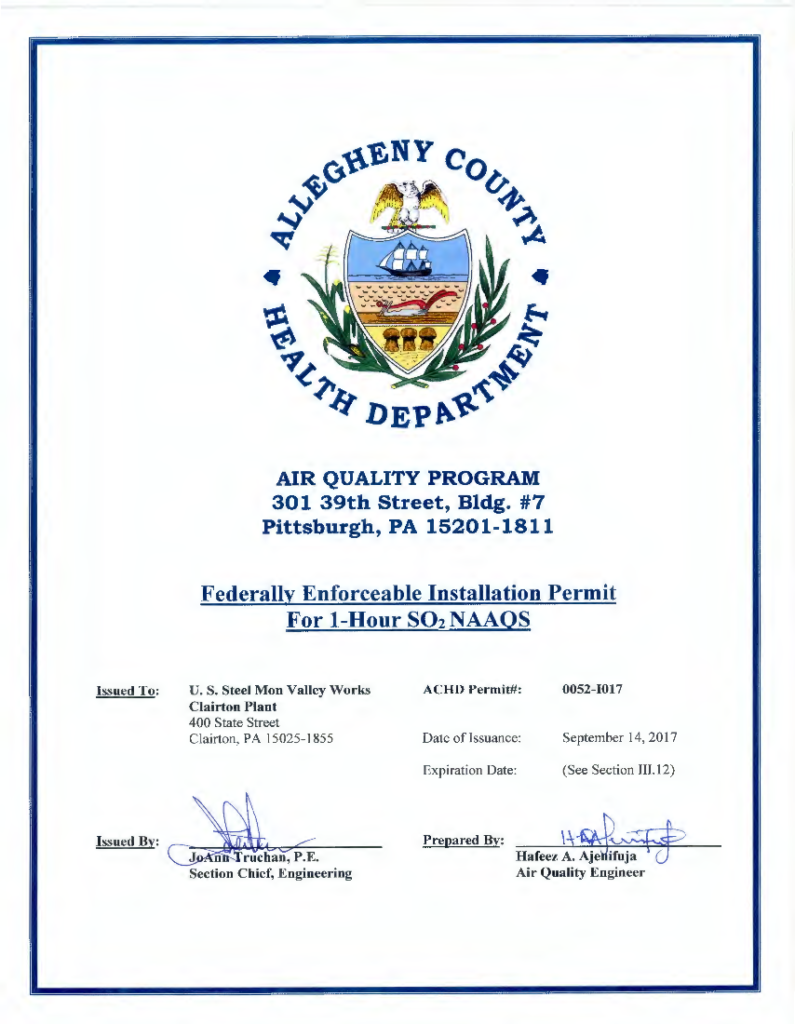
Full Permit: Clairton Installation Permit (23 pages)
2. Edgar Thomson Installation Permit, pages 1, 4-5, 18-21:
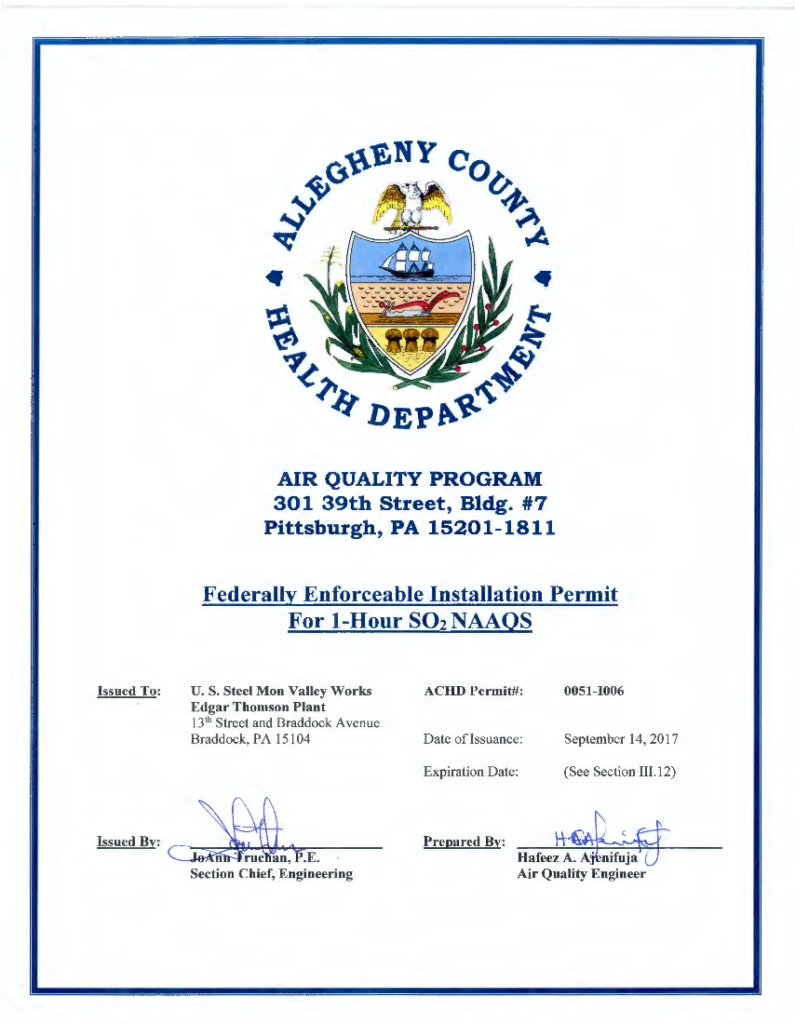
Full Permit: Edgar Thomson Installation Permit (21 pages)
3. Irvin Installation Permit, pages 1, 4-5, 18-20:
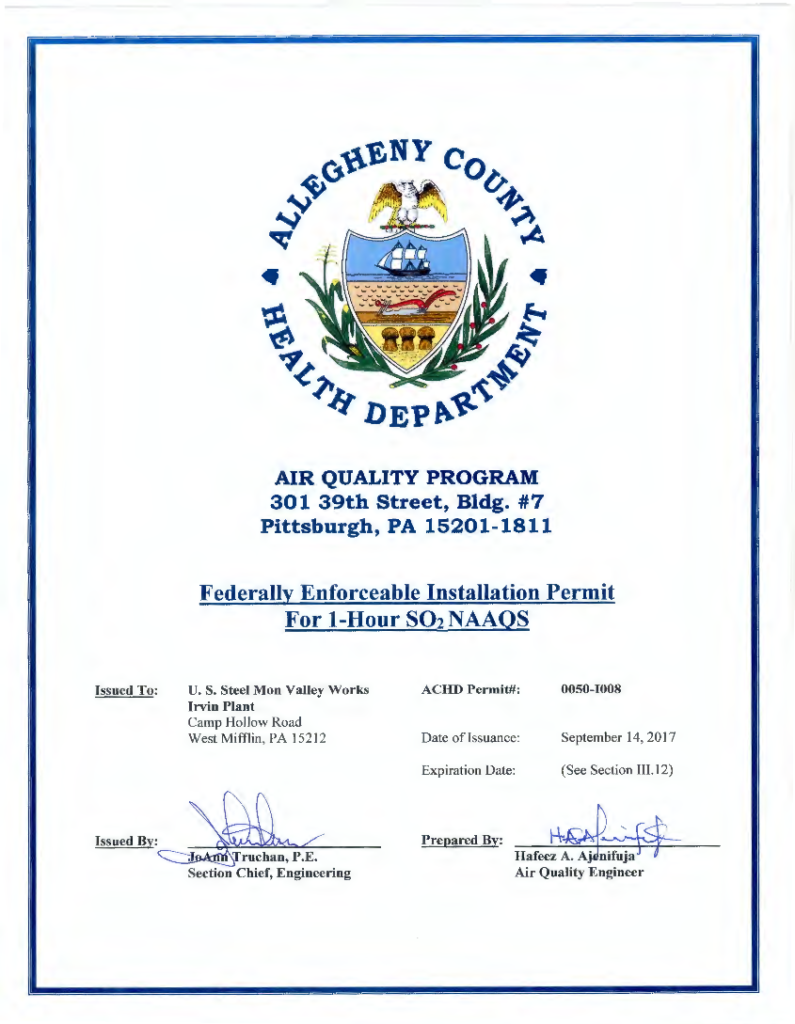
Full Permit: Irvin Installation Permit (20 pages)
4. Braddock Recovery Installation Permit, pages 1, 4, 18-19:
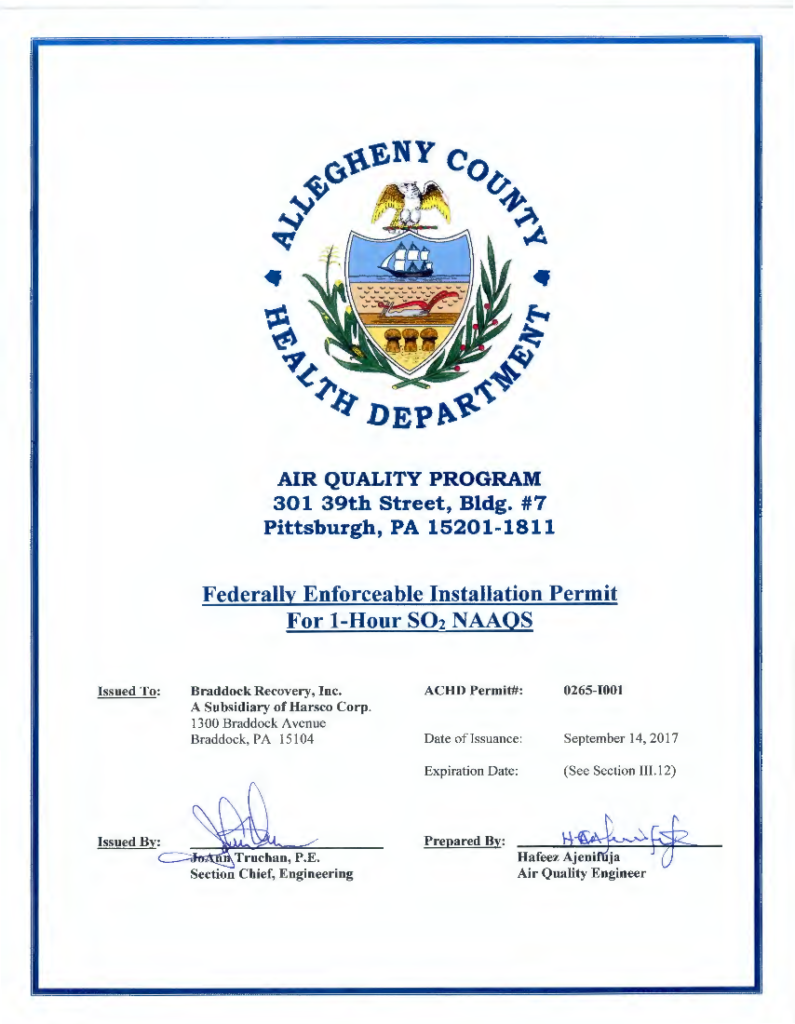
Full Permit: Braddock Recovery Installation Permit (19 pages)
In each of these permits, the Department reserves the right to require emissions testing beyond the periodic stack tests required every two years by the U.S. Steel permits.
IV. Sulfur Dioxide (SO2) State Implementation Plan
In 2017, the Department proposed revisions of its state implementation plan to demonstrate that it would come into attainment with the SO2 national ambient air quality standard of 75 parts per billion by the attainment date, October 4, 2018:
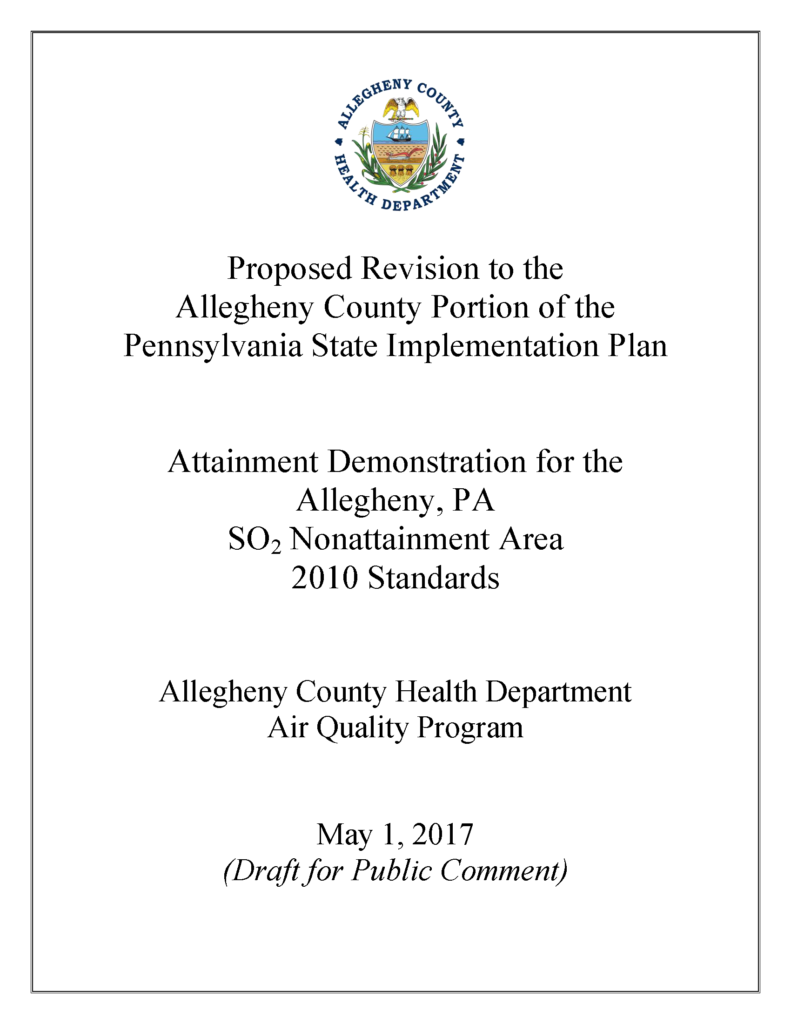
The Council provided comments on this proposed revision:
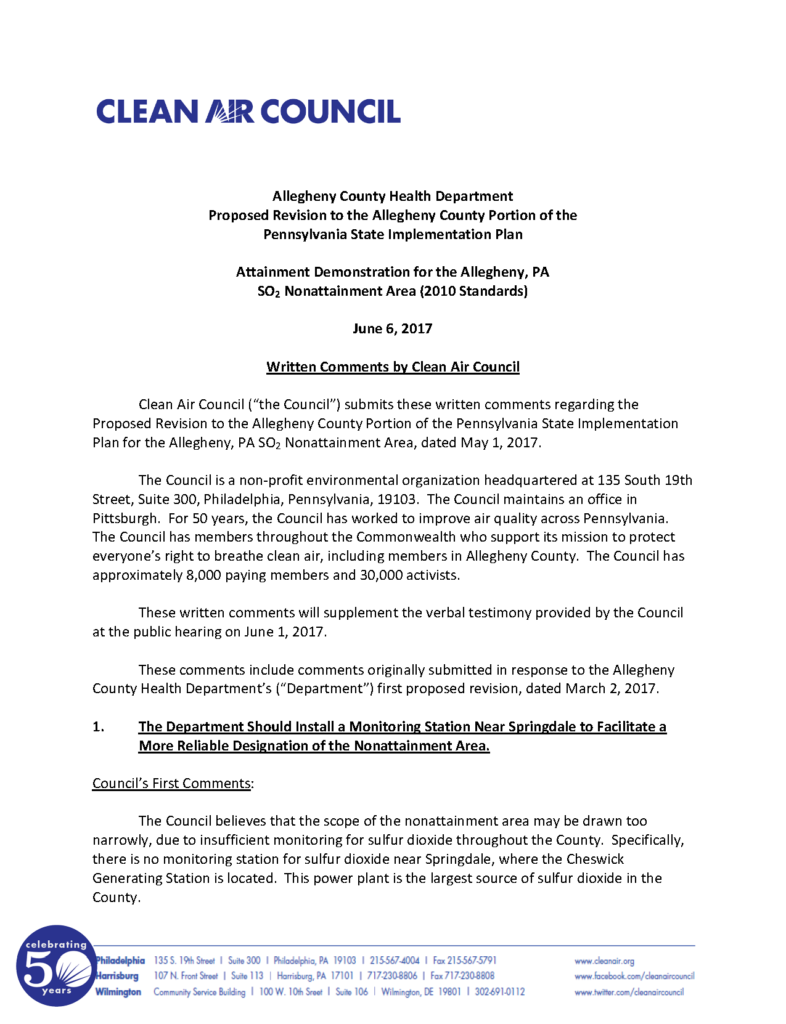
Among the Council’s comments, it noted that the Department was not requiring implementation of a control strategy more than one year in advance of the attainment date, contrary to a guidance document issued by EPA. (pages 8-11).
In addition, the Council commented that the contingency measures to be implemented in the event of nonattainment following the attainment date were not sufficiently specific. (pages 15-17).
The Department provided a response to comments on the proposed revision:
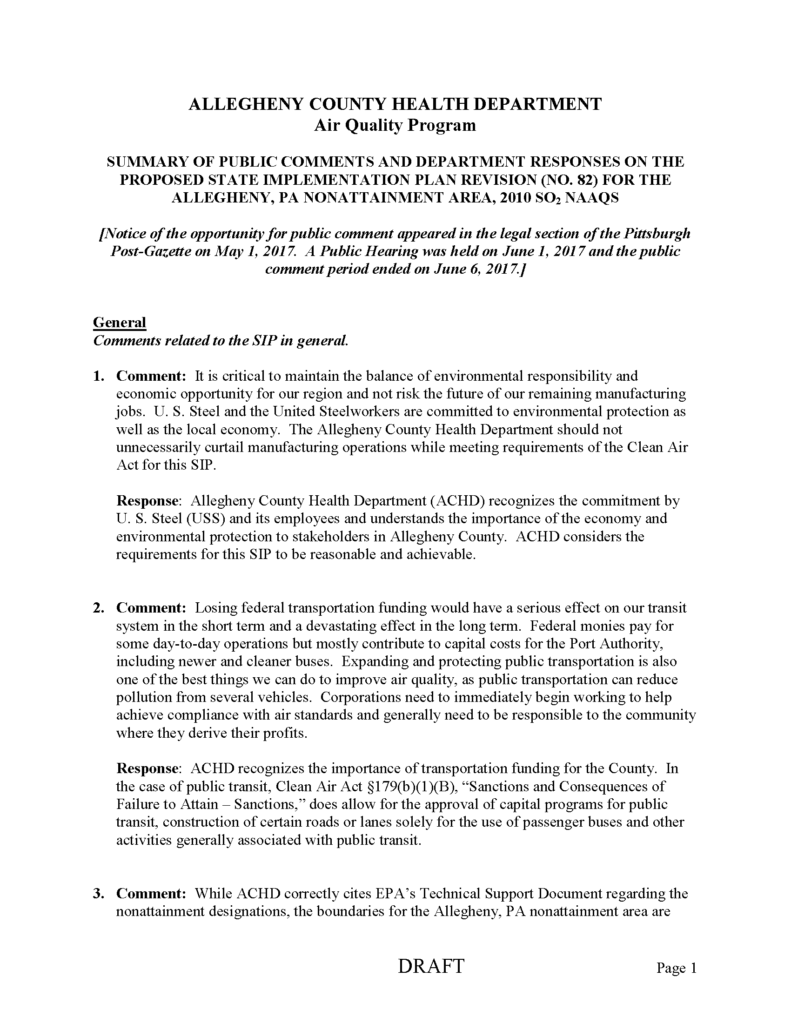
In response to the comment regarding the control strategy, the Department asserted that the design of the projects required a longer schedule, and that it was anticipated that there would be one year of attainment for 2018, and possibly a three-year design value for 2016-2018 below the NAAQS:
"Response: The design, construction, and implementation of all projects for this SIP necessitate the longer schedule than prescribed by the general NAAQS schedule. It is also anticipated that concentrations will be low enough in order to show one year of monitored attainment for year 2018, if not a design value for 2016-2018 below the NAAQS, for all monitor sites in the nonattainment area (NAA). Once monitored attainment has been achieved, the area must then be modeled using actual emissions from the three most recent years, which is also anticipated to show attainment." (pages 7).
In addition, the Department asserted that it would follow an aggressive enforcement plan to function as a contingency measure, in the case of future nonattainment:
"Response: Contingency Measures for this SIP define a detailed process for identifying the source(s) of violation of the SO2 NAAQS and aggressively following up with implementing corrective actions." (pages 27-28).
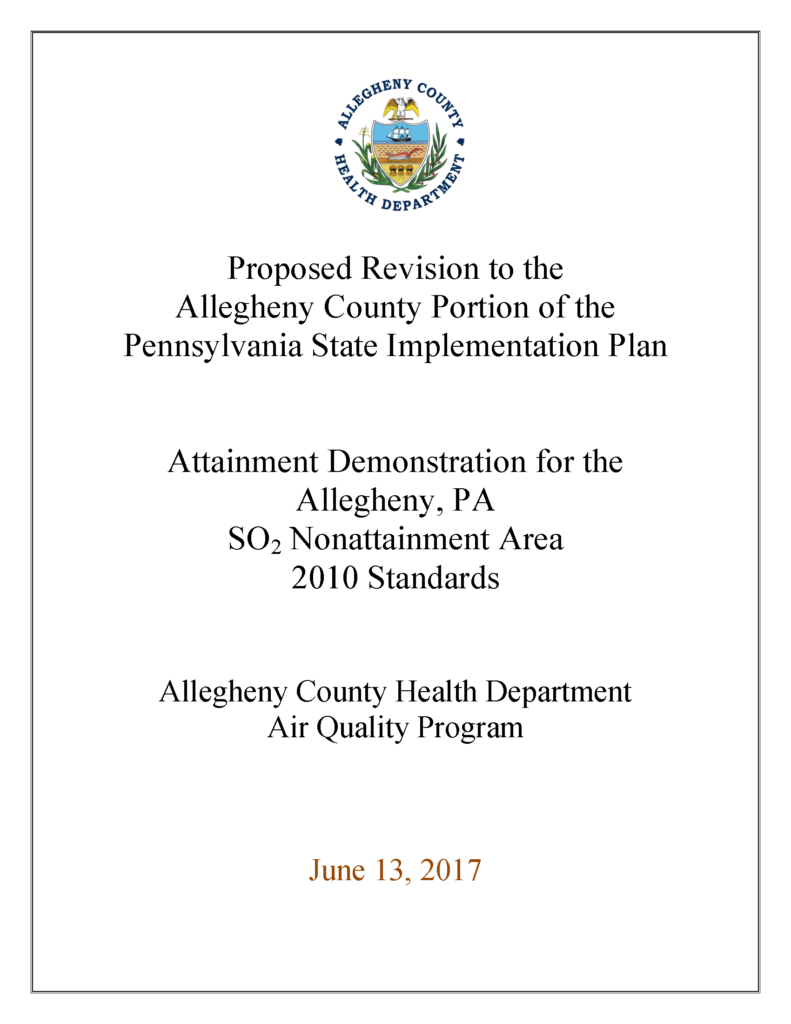
In November 2018, EPA proposed a rule that would approve the plan revision:
https://www.federalregister.gov/documents/2018/11/19/2018-25079/approval-and-promulgation-of-air-quality-implementation-plans-pennsylvania
On December 19, 2018, the Council provided comments on this proposal
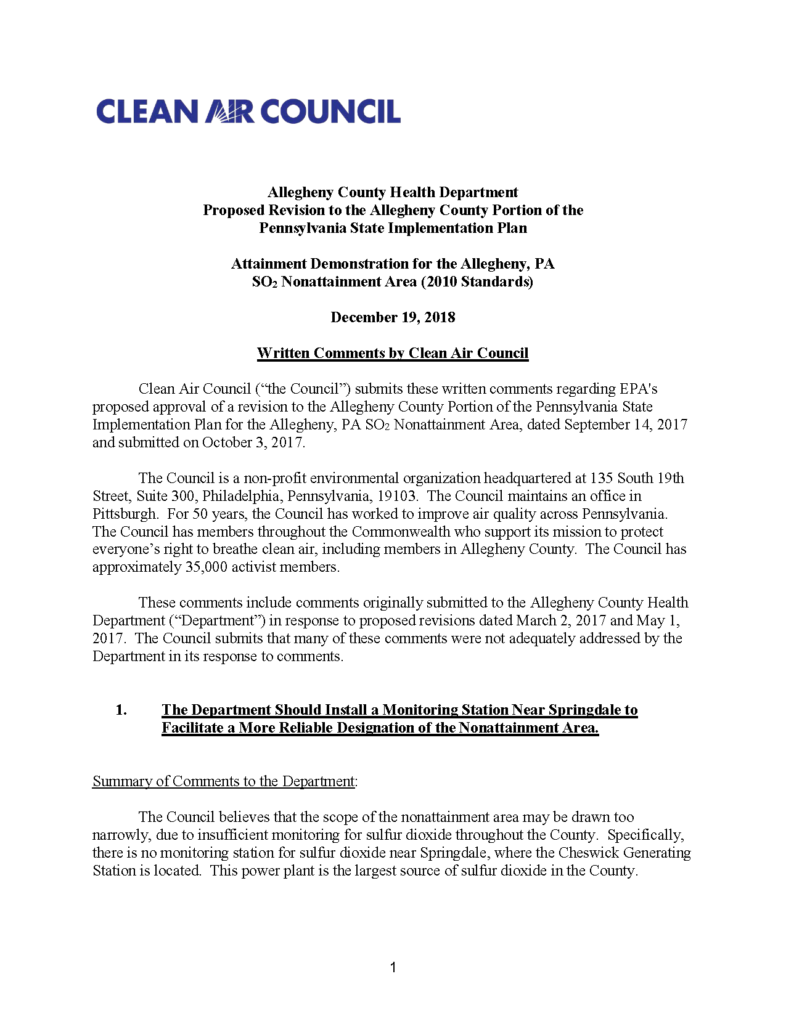
As of December 22, 2018, there has been a shutdown of the federal government. There has been no additional action on the proposed rule.
V. Evaluation of Attainment for SO2 Standard
Liberty Monitor
Based on raw data from the Liberty monitor (0064) for the three-year period 2016-2018, Allegheny County appears to be on track to be in nonattainment with the national ambient air quality standard of 75 ppb.
Based on the average of the following fourth-highest maximum hourly values for 2016, 2017, and 2018, the design value for the Liberty monitor appears to be 101 ppb, which is greater than the standard of 75 ppb, indicating nonattainment through 2018. This does not include an analysis of any alleged exceptional events.
05/12/2018: 130 ppb
08/15/2017: 116 ppb
11/27/2016: 64 ppb

2018 data (Liberty), 2017 data (Liberty), 2016 data (Liberty) (sorted by maximum daily concentration)
North Braddock Monitor
Based on on the average of the following fourth-highest maximum hourly values for 2016, 2017, and 2018, the design value for the North Braddock monitor (1301) appears to be 61 ppb, which is less than the standard of 75 ppb, indicating attainment through 2018.
02/21/2018: 68 ppb
02/10/2017: 63 ppb
03/01/2016: 51 ppb

Source: 2018 data (North Braddock), 2017 data (North Braddock), 2016 data (North Braddock)
(sorted by maximum daily concentration)
https://www.epa.gov/outdoor-air-quality-data/download-daily-data
Source: 40 C.F.R. part 50, Appendix T (attainment formula):
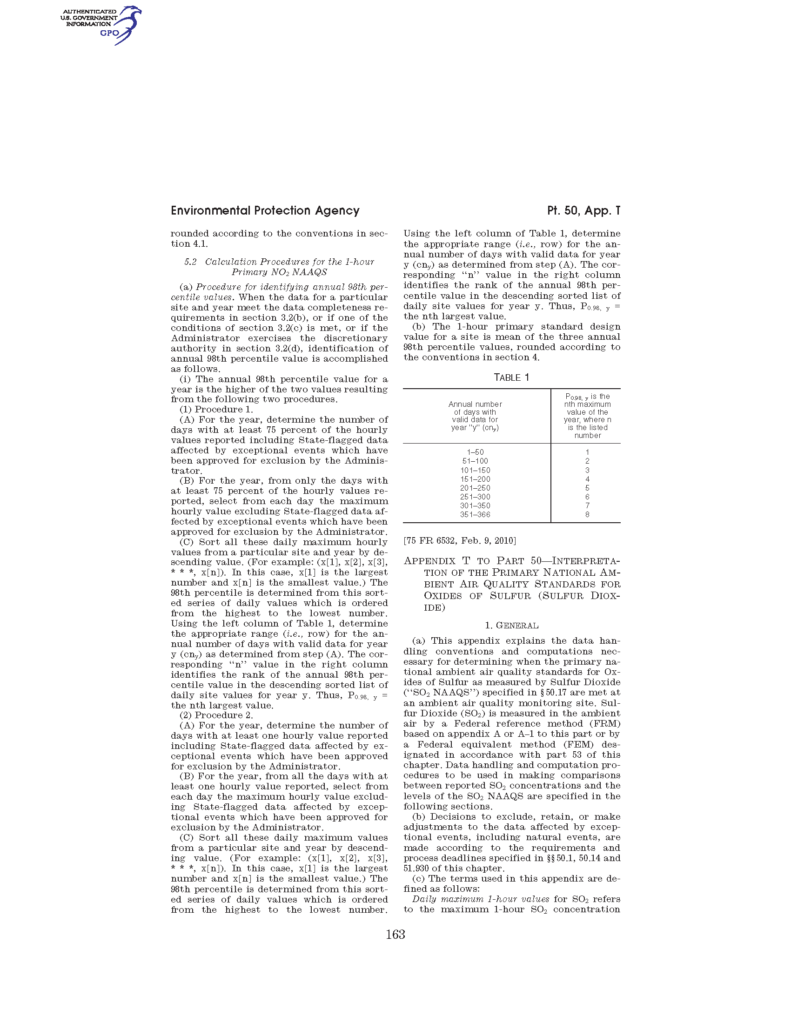
VI. Fine Particulate (PM2.5) State Implementation Plan
A. The Standard
Hourly concentrations of fine particulates at the Liberty 2 monitor are also used to evaluate attainment with an annual standard.
The annual standard is 12.0 micrograms per cubic meter (12.0 µg/m3). This is a yearly standard based on a design value. The design value results from averaging the hourly concentrations over a period of one year, and then averaging these annual averages over a period of three years. If the design value is greater than 12.0 µg/m3, the area is a nonattainment area.
EPA lowered the standard from 15.0 µg/m3 to 12.0 µg/m3 in 2013. 78 Fed. Reg. 3086, 3088, 3277 (January 15, 2013), https://www.govinfo.gov/content/pkg/FR-2013-01-15/. In doing so, EPA concluded that fine particulates cause premature mortality:
“Using a more formal framework for reaching causal determinations than used in prior reviews, [footnote omitted] the EPA concludes that a causal relationship exists between both long and short-term exposures to PM2.5 and premature mortality and cardiovascular effects and a likely causal relationship exists between long- and short-term PM2.5 exposures and respiratory effects.” 78 Fed. Reg. 3103.
Under this new lowered standard, EPA designated all of Allegheny County as a nonattainment area effective April 15, 2015. 80 Fed. Reg. 2206, 2264 (January 15, 2015), https://www.govinfo.gov/content/pkg/FR-2015-01-15/, 80 Fed. Reg. 18,535, 18,537-18,538, 18,549 (April 7, 2015), https://www.govinfo.gov/content/pkg/FR-2015-04-07/.
B. Nonattainment Status in Allegheny County
Since the time of the designation of nonattainment, the design value for fine particulates has been increasing:
2017 design value: 13.0 (2015-2017), 2017 Air Quality Annual Report
2016 design value: 12.8 (2014-2016), 2016 Air Quality Annual Report
2015 design value: 12.6 (2013-2015), 2015 Air Quality Annual Report
C. Missed Deadline for Plan Revisions
By October 15, 2016 (18 months after the effective date of the nonattainment designation), Allegheny County was required to submit a revision of its state implementation plan to address nonattainment with the lowered standard. See 81 Fed. Reg. 58,010, 58,026 (col. 2), 58,152 (col. 3) (August 24, 2016), https://www.govinfo.gov/content/pkg/FR-2016-08-24/. It did not do this.
Effective May 7, 2018, EPA published a finding that the Department failed to submit the revision. See 83 Fed. Reg. 14,759 (April 6, 2018), https://www.govinfo.gov/content/pkg/FR-2018-04-06/. The publication of this notice started the 18-month clock for sanctions under the Clean Air Act. See 42 U.S.C. §7509(a), https://www.law.cornell.edu/uscode/text/42/7509, 40 C.F.R. §52.31(c),(d), https://www.law.cornell.edu/cfr/text/40/52.31. That 18-month period will end on November 7, 2019.
As of February 7, 2019, the Department has still not made any of these submissions to EPA: emission inventory, reasonable available control measures/ reasonable available control technologies, attainment demonstration, reasonable further progress demonstration, quantitative milestones, contingency measures, nonattainment new source review. See EPA, Status of SIP Required Elements for Pennsylvania Designated Areas: https://www3.epa.gov/airquality/urbanair/sipstatus/reports/pa.
D. Recent Steps by the Department
In December 2018, the Department proposed a revision of its nonattainment new source review regulations -- one part of the larger submission that was due on October 15, 2016. See Revision Tracking No. 90A. This proposal involved the regulatory requirements for the construction or modification of major sources of air pollutants in Allegheny County. (There are 32 of these sources in the county, including the three U.S. Steel facilities).
In its comments, Clean Air Council suggested that the Department require an increased offset ratio for these projects. Clean Air Council Comments (December 18, 2018). For such projects to go forward, a facility already must obtain a reduction of emissions of fine particulates from other projects or sources to offset the increase in emissions from the project. (The minimum ratio is 1:1). In its comments, the Council suggested that the Department require an increased offset ratio of 1:5 to 1, following an example in California.
In its response to comments, the Department rejected this suggestion.
In a press release on February 6, 2018, the Department indicated that it would be proposing a revisions in the summer of 2019. See Press Release (“Already underway, ACHD will submit its PM2.5 State Implementation Plan this summer for consideration.”).
This submission will be nearly three years late.